Pasta con Acciuga (spaghetti alla Gennaro) - Anchovy Pasta
traditional pasta recipe from Naples, Southern Italian.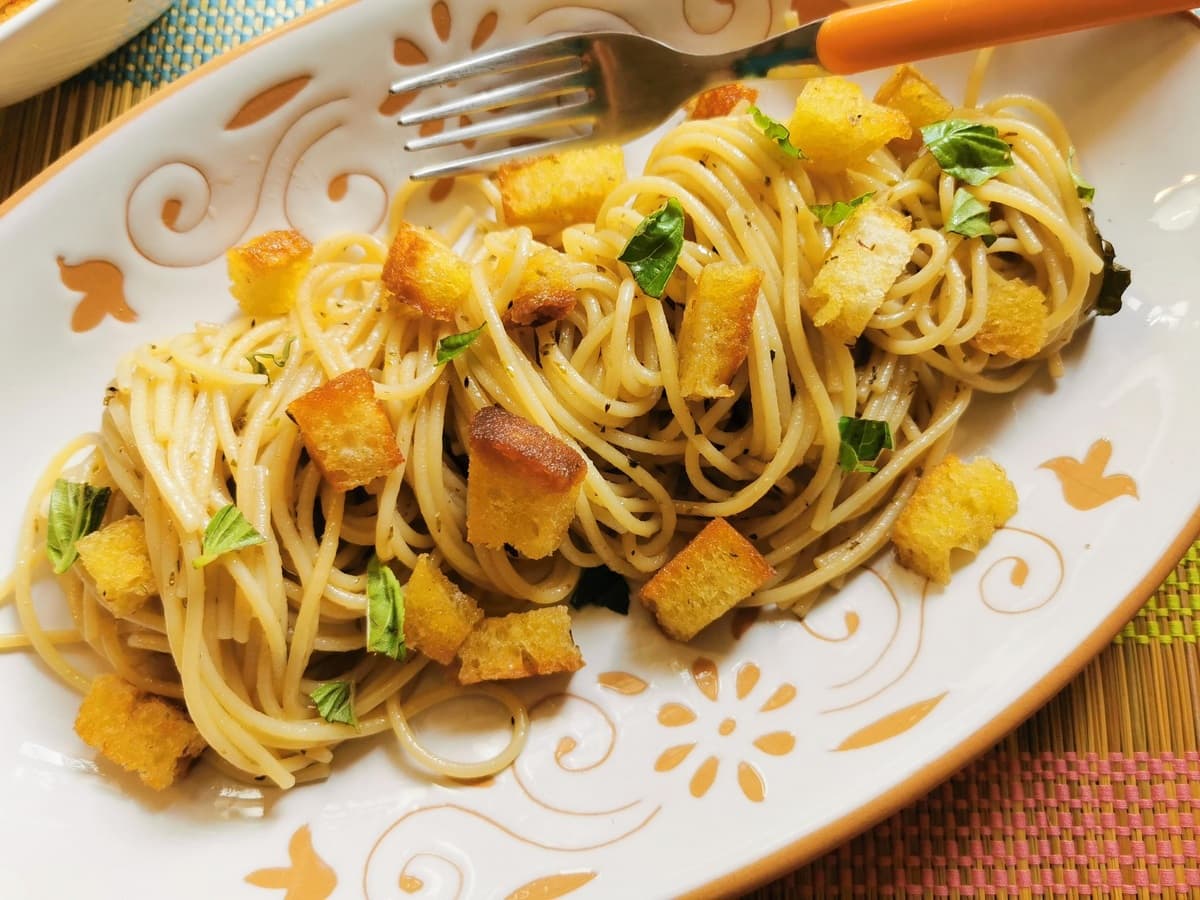
Ingredients:
- 12.5 oz spaghetti (360g)
- 6-8 anchovy fillets those preserved in oil.
- 4 slices semi-stale bread The best is country or farmhouse bread.
- 2-5 garlic cloves peeled
- 2 tsp dried oregano
- 5 tbsp extra virgin olive oil.
- fresh basil leaves washed and dried.
Method:
Prepare ingredients
- Peel the garlic cloves and cut 1 in half. Cut the anchovy fillets into small pieces. wash and pat dry the basil leaves.
- Put a pot of water onto boil for the spaghetti. Add salt once it starts to boil and bring to the boil again.
- Rub the bread slices with the cut garlic and cut them into small cubes for croutons.
- Saute 1-2 garlic cloves in olive oil in a skillet. Then add the croutons and fry on each side until golden and crispy. You can use breadcrumbs instead. These brown very quickly and need less olive oil. Remove croutons from the pan and set aside.
- Add more olive oil to the skillet and sauté the rest of the garlic and the anchovy pieces. Keep stirring the anchovy until it starts to melt and then add the dried oregano. Remove from the heat so the oregano doesn't burn.
- Cook the spaghetti al dente according to the instructions on the packet. Save a little pasta cooking water, drain the pasta and add it to the hot anchovy sauce with a little pasta cooking water (2-3 tbsps). The sauce may need to be reheated before adding the pasta.
- Mix the spaghetti with the sauce and then add some of the croutons. Mix again and then add the rest of the croutons and the fresh basil torn or cut into pieces. Serve immediately.
Spaghetti is the traditional pasta for this recipe but linguine or vermicelli could be used too.
Some Italians add peperoncino flakes to this recipe. If you’d like to do the same add them with the oregano.
You can use breadcrumbs (homemade or store bought) instead of the croutons or ready-made croutons.
Reference:
https://www.the-pasta-project.com/anchovy-pasta-recipe-from-naples/
Spaghetti all'acqua di limone - Lemon water spaghetti
avant-garde Neapolitan pasta recipe
Ingredients:
- 250 g spaghetti or linguine
- 3 1/2 lemons
- 100 g provolone del Monaco or other types of provolone dolce or parmesan
- 1 handful fresh basil leaves
- 500ml water
- 3-4 tbsp extra virgin olive oil
- salt to taste
- black pepper to taste
- lemon leaves optional
Method:
The night before
- Wash 3 lemons. Cut them into quarters and remove the pulp and discard it or use for something else. Put the peel into a bowl with 500ml water which has been heated to about 75/80 ° C. Leave covered until the next day.
- The next day, strain the lemon infused water into a small pot and bring it to the boil.
- In a large frying pan with high sides, add a large ladleful of the hot infusion, some olive oil and a pinch of salt, and once it boils again add the spaghetti (yes to the pan!).
- Keep stirring and adding more infused water (a small ladleful at a time) until the pasta is cooked. Don’t let the pan dry out or the spaghetti strands stick together. Keep the heat medium.
- Grate the peel of half a lemon.
- When the pasta is cooked and off the heat, add some more oil, the lemon zest and the cheese and stir well.
- Add the chopped basil and stir again.
- Serve immediately with a little more basil, ground black pepper and grated provolone or Parmesan
If you want to use lemon leaves. Wash and dry the lemon leaves. Cook in the microwave at maximum temperature until they are dry. (about 2 minutes). Blend and sieve through a tight sieve. Put aside. Sprinkle your ready dish with the dried lemon leaves before serving.
Reference:
https://www.the-pasta-project.com/lemon-water-spaghetti-pasta-recipe/2/
Fettuccine al aglio orsino con speck e radicchio - Wild garlic fettuccine pasta with speck and radicchio
from the Northern Italian region of Trentino-Alto Adige (South Tyrol)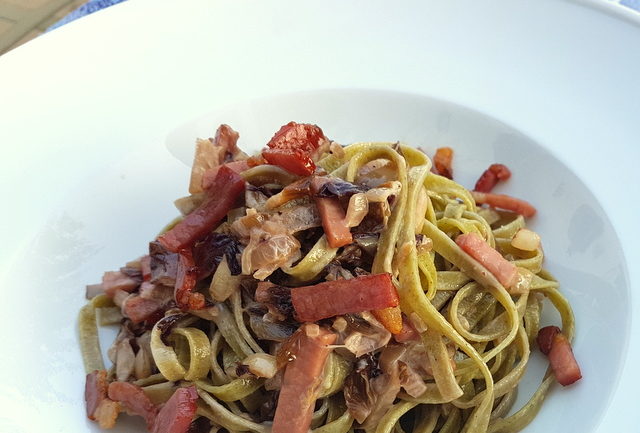
Ingredients:
- 350 g fettuccine or tagliatelle, pappardelle or penne
- 100 g speck or pancetta cut into small cubes or strips
- 1-2 red radicchio (Italian chicory)
- 1 small white onion
- 1/2 glass of white wine
- 100 ml heavy cream (or italian cooking cream)
- 50 g parmesan grated
- salt for pasta and to taste
- black pepper to taste
- 2-3 tbsp extra virgin olive oil
- 1 handful walnut pieces
- Wash and shred the radicchio (soak leaves in water for 20 minutes before shredding if you want to reduce the bitterness) Finely chop the onion and cut the speck into cubes or short strips.
- Heat the olive oil in a frying pan or skillet and add the onion and 2/3 of the speck. Sauté for a couple of minutes until the onion becomes translucent.
- Add the shredded radicchio and a pinch of salt. Cover and let cook on a low flame for about 10 minutes. Stirring occasionally.
- In the meantime, put a pot of water on to boil for the pasta. Add salt once it starts to boil and bring to the boil again.
- Fry the rest of the speck in a small frying pan with a dash of olive oil until it becomes crispy.
- Pour the white wine into the pan with the radicchio, turn up the heat and cook until the alcohol has evaporated.
- Add the cream to the radicchio, stir and simmer on a low heat for another couple of minutes. Add salt and pepper to taste. (don’t be too generous with the salt as speck tends to be a little salty)
- Cook the pasta al dente according to the instructions on the packet. Once the pasta is cooked, save a cup of the cooking water and drain the pasta.
- Add the pasta to the pan with the sauce. Add some of the pasta cooking water if the sauce seems dry. Mix the pasta and sauce together well.
- Serve with a sprinkling of crispy speck, walnuts (optional) and grated Parmesan.
This recipe can be made with pancetta instead of speck and other types of pasta ribbons such as tagliatelle or pappardelle. You can also use short pasta such as penne.
Reference:
https://www.the-pasta-project.com/pasta-with-speck-and-radicchio-italian-chicory/2/
https://www.the-pasta-project.com/pasta-with-speck-and-radicchio-italian-chicory/
Pasta con agnello e carciofi - Pasta with lamb and artichokes
from the island of Sardinia which is famous for the quality of its lamb and artichokes!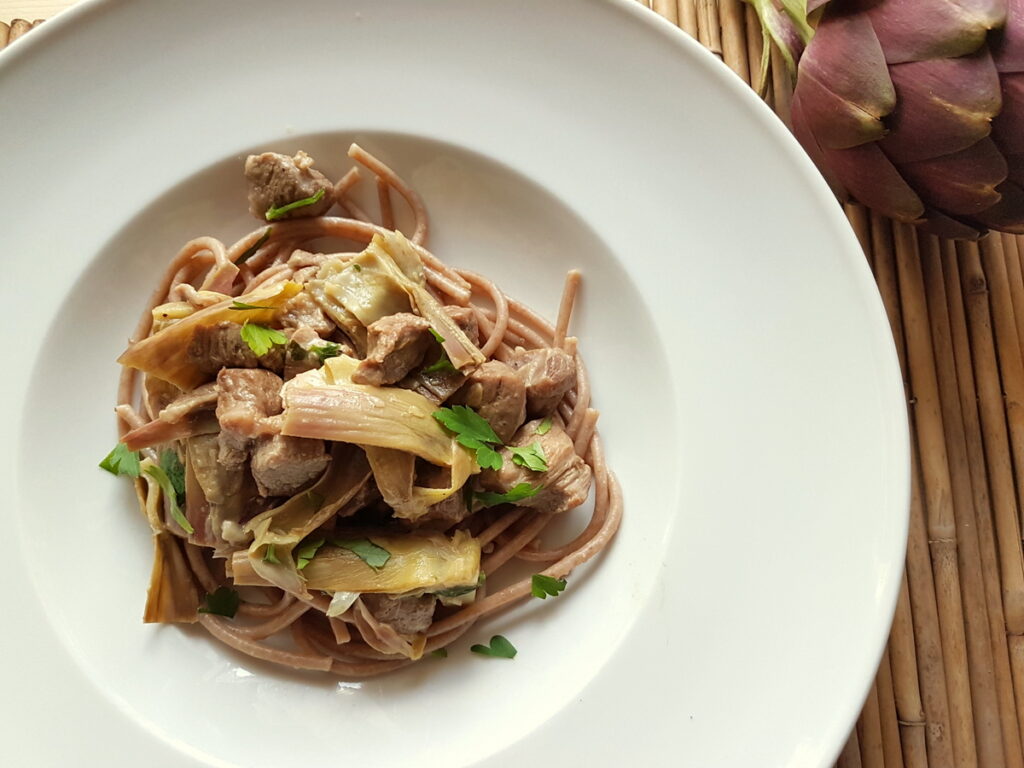
Ingredients:
- 320 g pasta such as spaghetti, tagliatelle etc (12oz) I used tumminia spaghettoni
- 400 g boneless lamb (14oz) Shoulder is good. I cut the meat off neck chops and used the bones to make stock
- 2 lemons
- 4 fresh globe artichokes outer leaves removed
- 2 garlic cloves peeled and chopped
- 1/2 glass white wine
- 1 cup stock chicken or veg stock is good. I made lamb stock
- salt for pasta and to taste
- 1 handful fresh parsley chopped
- black pepper to taste
- 3 tbsp extra virgin olive oil
- 1 carrot washed and cut in half
- 1 celery stalk washed and cut in 3 pieces
- 1 onion peeled and cut in half
- 1 bay leaf
- lamb bones
- Cut the lamb’s meat into small cubes and keep aside. (I used neck chops and made stock with the bones)
- Clean the artichokes by removing the outer leaves and the inner beard, cut them into thin slices and place them in a large bowl with the juice of 1 lemon, so that they do not blacken.
- In a large frying pan or skillet, heat the olive oil and add the peeled and chopped garlic cloves.
- Once the garlic has softened a little, add the chunks of lamb and brown for a couple of minutes, turning often.
- Season with salt and pepper , add the artichokes and cook over high heat for a few minutes.
- Add the white wine and leave the heat high until the alcohol evaporates.
- Add I cup of stock or hot water, cover and cook over a low heat for about 20 minutes.
- In the meantime, pot a pot of water on to boil for the pasta. Add salt once it starts to boil and bring to the boil again.
- Squeeze the juice from the second lemon and grate the rind to make a teaspoon of lemon zest.
- Add the lemon juice to the meat sauce. If necessary turn the heat up to reduce the sauce if it is too liquid. Add some of the fresh parsley to the sauce and mix it in.
- Cook the pasta slightly less than al dente according to the instructions on the packet. Save a cup of the cooking water and drain the pasta. Then add it to the pan with the sauce.
- Mix everything together carefully so the pasta doesn’t break and the let the pasta finish cooking in the sauce. Depending on the type of pasta you use this could take a minute or 5 minutes. If the sauce seems dry add some of the saved pasta cooking water.
- Serve immediately with a sprinkling of lemon zest and some chopped fresh parsley.
- just put the lamb bones, carrot, celery, bay leaf and onion into a pot. Add a pinch of salt. Cover with water, bring to the boil and simmer half covered for at least one hour. If the stock has a lot of fat that rises to the surface, you can skim this off before using it in the sauce.
Cooking and preparation times do not include making your own stock.
I would recommend whole-wheat pasta such as tumminia pasta, but you can use whole-wheat or normal and different types such as tagliatelle, pappardelle or spaghetti. Short pasta such as penne would also go well.
This dish can also be served without pasta. The lamb needs to be cut into larger pieces and the artichokes added after the lamb has cooked for an hour in wine and stock.
Reference:
https://www.the-pasta-project.com/pasta-with-lamb-and-artichokes/
Spaghetti with Agretti (Salsola Soda)
Central Italy
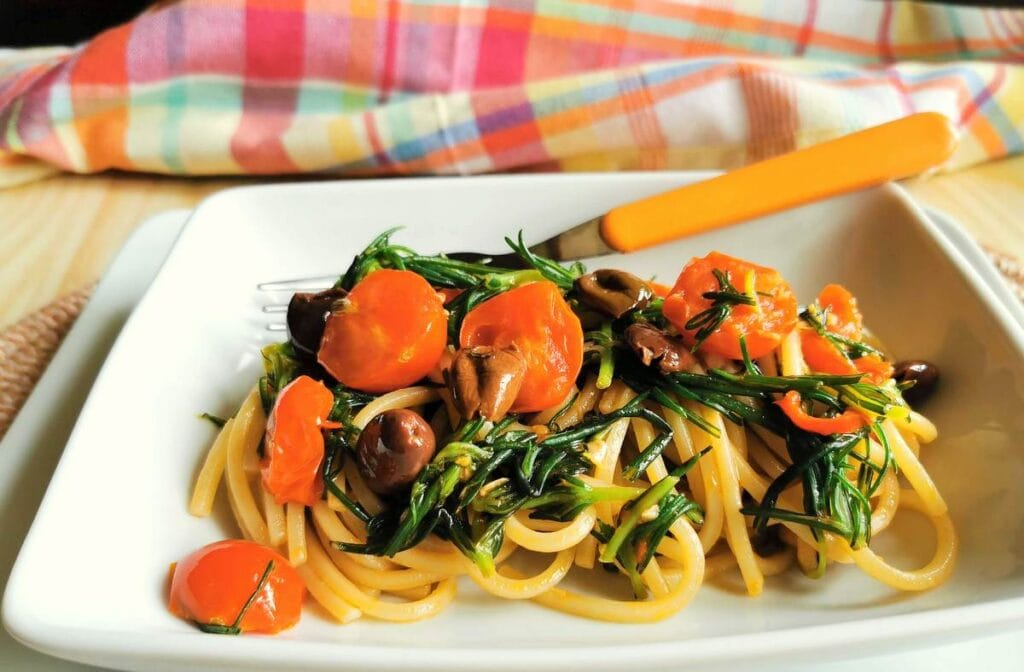
Ingredients:
- 320 g spaghetti alla chitarra or normal spaghetti
- 250 g agretti (9oz) also called monk's beard or saltwort
- 1-2 cloves garlic peeled and finely chopped
- 1/2 fresh peperoncino (red chili pepper) seeds removed and chopped (optional)
- 60 g black olives (2oz) pitted. I used taggiasca olives
- salt for pasta, agretti and to taste
- freshly ground black pepper. to taste
- 3-4 tbsp extra virgin olive oil.
- 50 g Parmigiano Reggiano (2oz) optional for non vegetarians
Method:
Prepare the ingredients
- Clean the agretti by removing the roots, the hard part of the stem and any yellow bits. Wash the leaves under cold water. Wash and half the cherry tomatoes, peel and chop the garlic, chop the peperoncino (if using) and cut the olives in half if they are big.
- Put a pot of water onto to boil for the agretti. Add a little salt when it starts to boil and cook/blanch the agretti for 3-5 minutes. I removed the agretti from the water and used the same water for the pasta. However, you can boil a fresh pot of water for the pasta if you prefer. Set the drained agretti aside.
- Sauté the chopped garlic and peperoncino (red chilli pepper) in olive oil until they start to soften. Add the cherry tomato halves and cook until they start to soften too. Add the olives and cook for another minute then add the agretti and sauté everything together for a couple of minutes. Season with salt and pepper to taste.
- Cook the spaghetti in the boiling salted water until al dente according to the instructions on the packet. Save some of the cooking water and drain the pasta. Add the pasta to the agretti and mix everything together well. If the sauce seems dry, add some of the saved pasta cooking water. Serve immediately with grated Parmigiano if required.
This recipe can be made with dandelion greens or spinach instead of agretti.
Reference:
https://www.the-pasta-project.com/spaghetti-with-agretti-salsola-soda/
Bucatini or Spaghetti All’ Amatriciana
from Amatrice in Lazio.
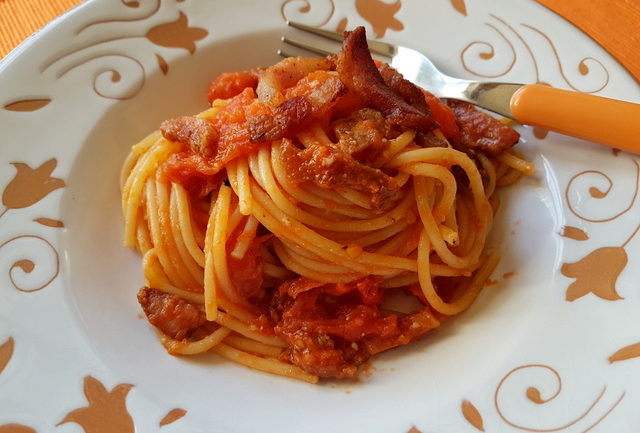
Ingredients:
- 400 g spaghetti or bucatini (14oz)
- 150 g cured pork cheek (5oz) Guanciale di Amatrice is the traditional type but you can also use thick slices of pancetta but preferably not the ready cubed one .
- 1 tbsp extra virgin olive oil Some cooks believe it’s not necessary to add oil as the pork is already quite fatty
- 1/2 glass dry white wine
- 400 g San Marzano tomatoes peeled
- 1 fresh peperoncino or teaspoon of dried peperoncino flakes
- 100 g grated pecorino cheese (3.5oz) Traditionally pecorino from Amatrice which is less salty than other types
- black pepper
- salt for pasta and to taste
Method:
- Thoroughly clean the pork cheek and cut it into small strips. Blanch the tomatoes in boiling water and peel them. Cut them in halves or quarters and remove most of the seeds.
- Put a pot of water on to boil for the pasta. Add salt when it starts to boil and bring to the boil again.
- Heat the oil in a frying pan (traditionally a cast iron pan) and add the pork cheek and let it brown.
- Sprinkle with the white wine. Allow the wine to evaporate and add the peperoncino (if using a whole fresh one, remove before serving)
- When the pork cheek is browned nicely, remove it from the pan and remove some of the rendered fat too. Add the peeled and cut tomatoes to the pan and cook on a medium heat until they start to soften. If you think you need more sauce you can add a little tomato passata too.
- Put the pork cheek into the sauce with some salt and pepper (taking into account that the pork is quite salty already). Simmer for 10-15 minutes.
- Meanwhile, cook the pasta al dente in the boiling salted water according to the instructions on the packet
- Drain the pasta and add it to the sauce with some of the pecorino, keeping the heat very low while you mix everything well together.
- Serve immediately with a sprinkling of more pecorino.
There are no other ingredients in the original recipe. Some people add onions, garlic, celery or carrot, but the taste of the sauce will change slightly with different ingredients. In Rome, onion is often added.
If you can’t find or don’t like pork cheek (guanciale) you can also use pancetta.
Reference:
https://www.the-pasta-project.com/amatriciana/
Spaghetti Arrabbiata (all'arrabbiata) - angry spaghetti
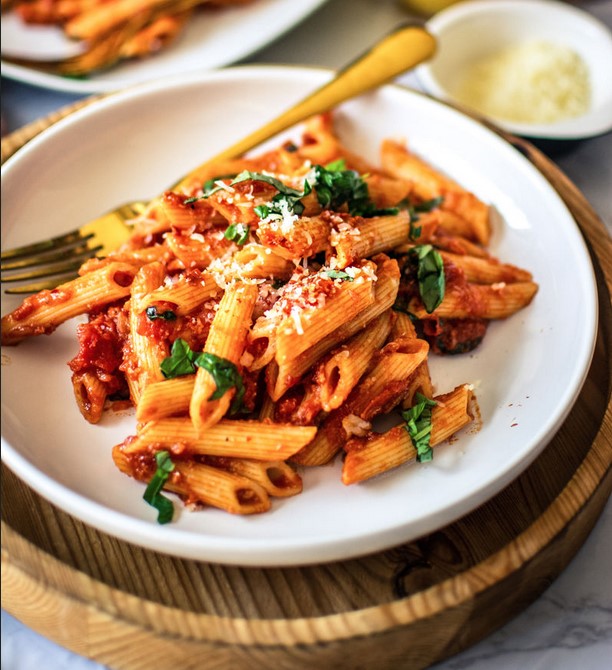
Ingredients:
- 1 medium yellow onion minced
- 6 cloves garlic minced
- 2 tsp red pepper flakes + more to your taste buds
- 2 X 28 oz can San Marzano Tomatoes whole
- 1/4 c extra virgin olive oil
- 1 bay leaf
- sea salt to taste
- 15 leaves basil torn
- 1 lb penne pasta or spaghetti
- In a large heavy bottom cast iron pan heat up the olive oil and saute the onion with a pinch of sea salt until translucent, about 10 minutes. Add the garlic and red pepper flakes and let it cook only for a few seconds until you can smell it and doesn’t get any color on it.
- In a large bowl crush the tomatoes with your hands but leave a few smaller chunks in there. Transfer them to the pot with the onions and garlic and brig to a simmer. Add the bay leaf and partially cover with a lid. Allow the sauce to simmer away on low flame for about 1 hour until thick and concentrated in flavor. Make sure to stir often, every 10 minutes or so, making sure the sugars in the tomatoes do not burn.
- Turn off the flame and season to your taste with the sea salt. Stir in the fresh basil leaves and finish it with a drizzle of extra virgin olive oil. Serve with pasta or meats or some fresh crusty bread.
- Meanwhile bring a large pot of water to a rolling boil. Season with sea salt, you want this to taste like sea water. Cook the penne pasta or spaghetti until al dente, according to the directions on the package. Toss to coat well in the arrabiata sauce and serve with a drizzle of olive oil and extra red pepper flakes.
Reference:
https://ciaoflorentina.com/arrabiata-sauce/
Spaghetti all’Ascolana - Olive and Tuna Spaghetti
from the Ascoli Piceno province in the Marche region of Italy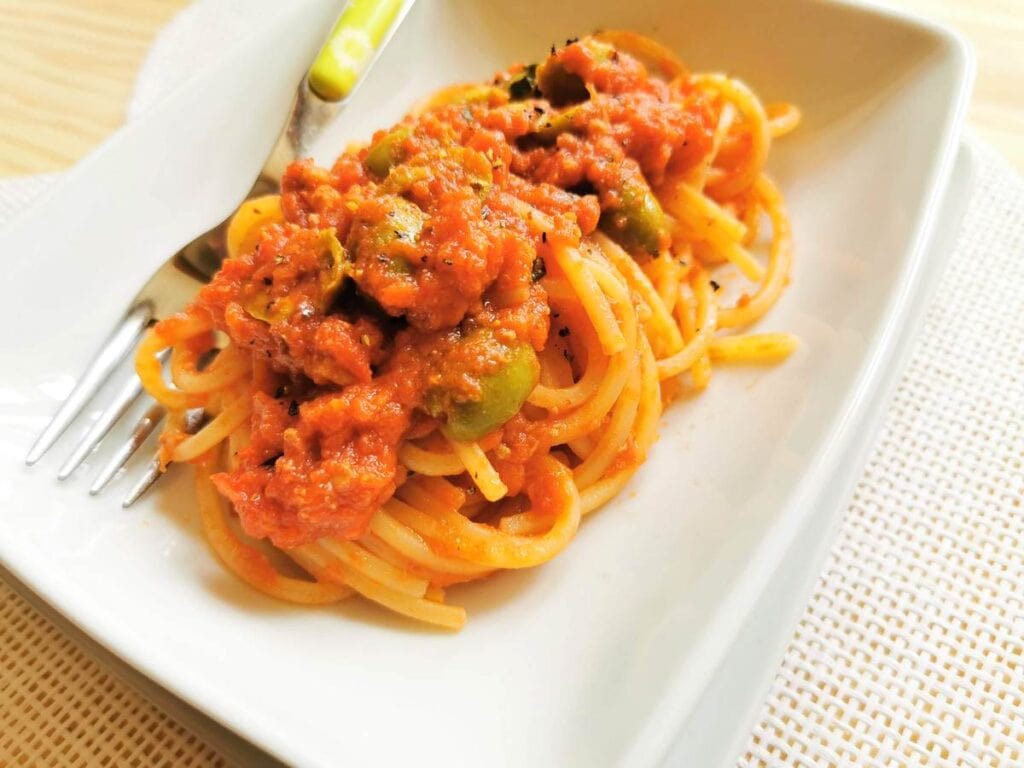
Ingredients:
- 400 g spaghetti or bucatini (14oz) you can also use penne or ziti.
- 350 g tomato passata (12oz) purée or crushed
- 200 g quality tuna in olive oil (7oz)
- 200 g large pitted green olives (7oz) best are Ascolana olives, green Castelvetrano or Cerignola from Italy or Gordal from Spain
- 4-6 anchovy fillets in oil removed from the oil and chopped
- 2 garlic cloves peeled
- 1 handful fresh parsley chopped
- 1/2 red peperoncino or 1/2 tsp peperoncino flakes chopped
- salt for pasta and to taste
- freshly ground black pepper. to taste
- 4-5 tbsp extra virgin olive oil
Method:
Prepare the ingredients
- Drain and chop the tuna, peel the garlic and chop the fresh peperoncino if using. (remove the seeds to make it less spicy). Cut the olives into halves or rounds. If they still have stones, you’ll have to pit them. Chop the parsley.
- Heat the oil with the garlic cloves and peperoncino in a heavy pan. Add the pitted and chopped olives. Let everything fry for a few minutes, then add the tomato passata (puree) and a little salt and pepper, mix, cover and cook for about ten minutes. Add the drained and chopped tuna, the chopped anchovies and the chopped parsley. Stir,continue cooking for another 5-10 minutes and turn off the heat. Remove the garlic cloves.
- Put a pot of water on to boil for the pasta. Add salt once it starts to boil and bring to the boil again. Cook the pasta al dente according to the instructions on the packet. When ready, save some pasta cooking water and drain. Add the pasta to the Ascolana sauce and mix everything together. If the sauce seems dry, add a little of the pasta cooking water. Serve with more chopped parsley and red chilli if required.
Some people like to cook the anchovies at the beginning with the garlic and chilli pepper. This was they tend to melt and leave a deep umani flavour without being noticeable.
Reference:
https://www.the-pasta-project.com/olive-tuna-spaghetti-allascolana/
Spaghetti all'assassina - Assassin's Spaghetti (Puglia’s killer spaghetti)
A cult recipe from Puglia (the Southern Italian city of Bari).
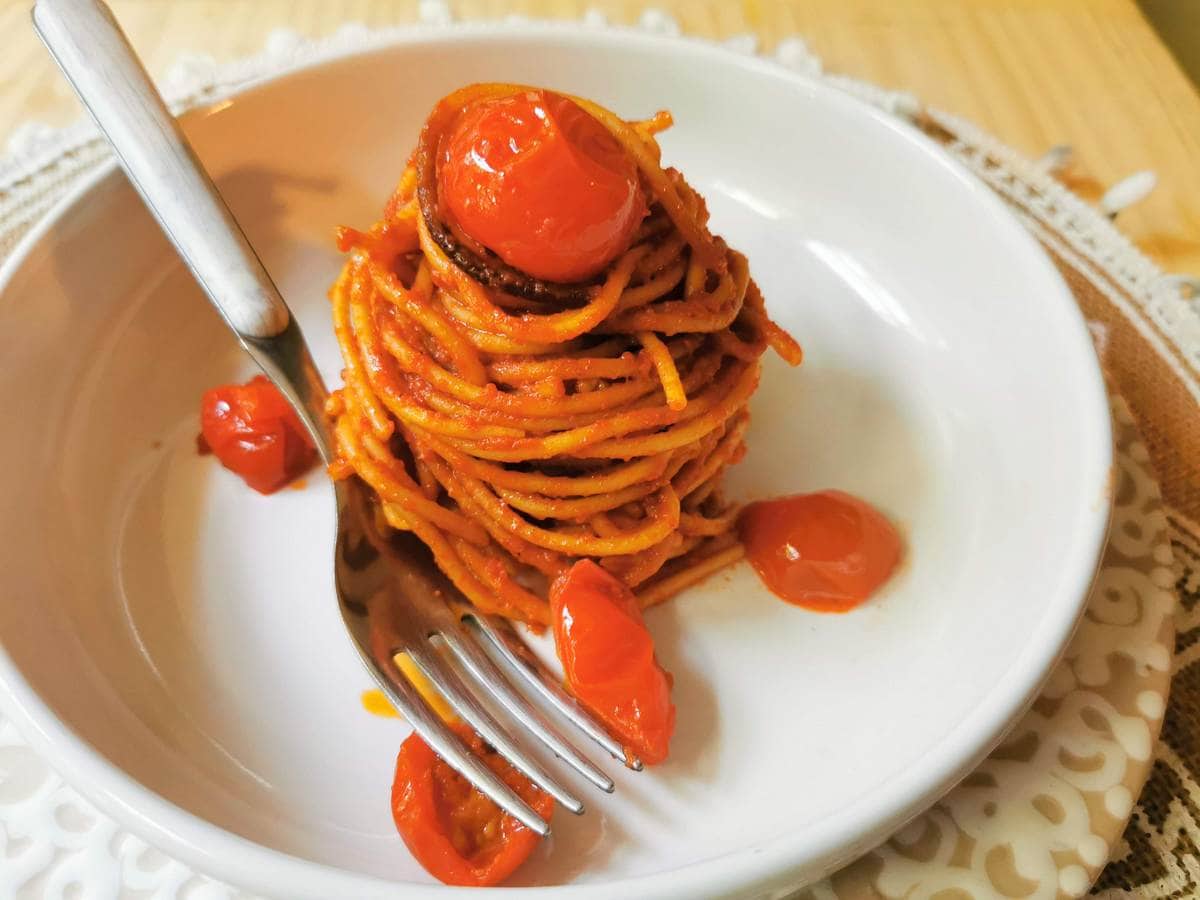
Ingredients:
- 320 g spaghetti or vermicelli (12oz) fine spaghetti is better. I used spaghetti Di Martino
- 400 g tomato passata (14oz) homemade or store-bought
- 1-2 tbsp tomato paste/concentrate
- 100 ml extra virgin olive oil. (1/2 cup)
- 2-3 garlic cloves peeled and 1-2 chopped, 1 left whole
- 1 fresh peperoncino (red chili pepper) or 1/2 tbsp flakes or according to taste
- 1-2 tsp sugar optional
- salt and pepper to taste
- 12 cherry tomatoes optional
- Peel the garlic and chop 1-2 cloves finely. If using a fresh red chilli cut into small pieces. Remove the seeds if you prefer it less spicy.
- Prepare a broth made with water, 2/3 of the tomato passata/purée (1:1), and the tomato paste and salt, and bring to a boil and simmer. You want the broth to be a bright red and tasty, but still a broth. This broth needs to be hot when you add it to the spaghetti, otherwise you will lower the cooking temperature for the pasta.
- In a cast iron pan, add ½ cup of olive oil, 2 garlic cloves (one whole one chopped), and red chili pepper according to how spicy you want your spaghetti to be. Cook the garlic over a high flame until golden then remove the whole garlic clove and pour in the 1/3 of undiluted tomato passata/purée. To temper the acidity from the tomatoes, you can add 1 tsp. sugar.
- Spread the passata over the whole pan with a wooden spoon and let it reduce and thicken slightly. At this point put the uncooked spaghetti in the pan, distributing the pasta a way that it lies on top of the sauce. NB the passata will spit when first poured into the pan so take care not to get burnt
- Wait for the underside of the spaghetti to start caramelizing before turning it over. This must be done carefully, a little at a time using a spatula. Let the otherside of the spaghetti start to crisp a little and then pour in a ladle of the hot tomato broth. It’s better not to pour it over the spaghetti but to add it to the sides of the pan.
- At this point the spaghetti should start to soften enough that you can move and stir it gently with a wooden spoon. Move any pasta strands that might have stuck to the bottom of the pan and allow the tomato broth to spread. Once the tomato broth has reduced and the spaghetti starts to stick a little again add more broth.
- Keep repeating this step (adding tomato broth and stirring the spaghetti) until the spaghetti is coated in the sauce and cooked. If you run out of tomato broth, you can add a little water. NB when finished, this dish is relatively dry and crispy, not saucy.
- I added cherry tomatoes which I had first sautéed in the iron pan before starting on the pasta. I removed them from the pan and then just added them back when my spaghetti all’assassina was ready. This step is optional.
- Serve your spaghetti all’assassina immediately topped with Parmigiano, stracciatella or just as is.
Spaghetti all’assassina is made in a unique way. The pasta cooks in the sauce, not in boiling salted water. Italians call this method ‘risottata’, meaning risotto style.
The spaghetti caramelizes in a small quantity of tomato passata before the rest of the sauce is added a little at a time until the pasta is al dente.
The pan should be iron.
It’s better to use fine spaghetti. Traditionalists recommend not using bronze extruded pasta but I did because I prefer that quality of pasta.
Reference:
https://www.the-pasta-project.com/spaghetti-allassassina-assassins-spaghetti/
Variations of spaghetti all’assassina:
Assassina di rape: made with broccoli rabe and stracciatella cheese,
Assassina di mare: with squid and prawns
Assassina con nolche oliva: with fried nolche olives (a sweet table olive).
B
Spaghetti con baccalà alla ghiotta - Spaghetti with salt cod
from Sicily
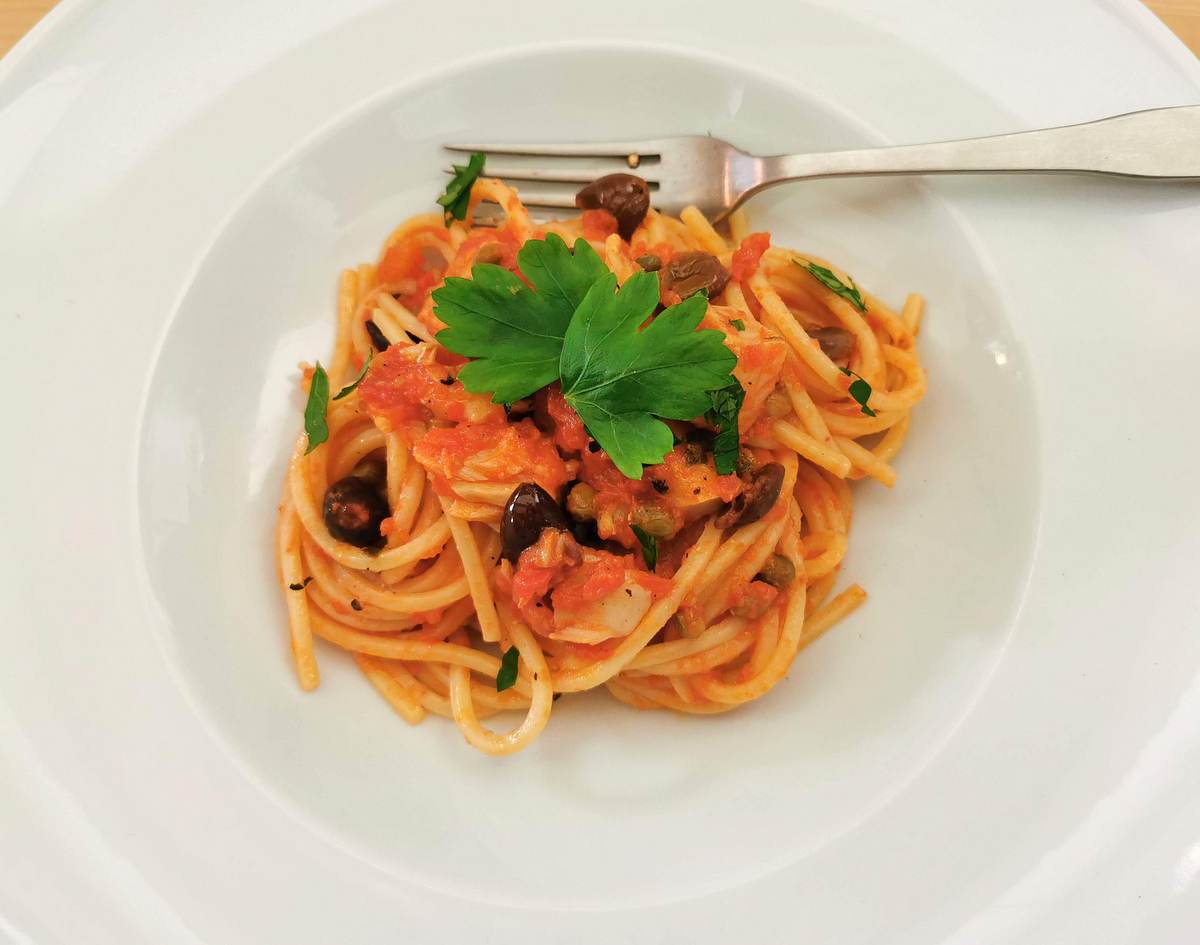
Ingredients:
- 600 g salt cod/ baccala (1.3lbs) prepared for cooking
- 400 g spaghetti (14oz) I used spaghetti alla chitarra but normal spaghetti is good too.
- 1 onion peeled
- 2 celery medium sized stalks
- 50 g green olives (2oz) destoned (I used taggiasche)
- 2 tbsp capers (I used salted)
- 400 g tomato passata (14oz) preferably rustica which is chunkier
- 10-12 cherry tomatoes cut in half
- 3 tbsp extra virgin olive oil.
- 4 potatoes peeled medium (optional)
- salt for pasta
- freshly ground black pepper. to taste
Method:
- Begin by putting the salted capers (if using) in a bowl, rinse them well to get rid of the salt.
- Chop the onion and celery into small pieces.
- Heat the olive oil in a frying pan or skillet. Add the onion, celery, olives and capers and cook until the onion becomes translucent.
- Add the cherry tomatoes, cut in half. and when they start to soften add the passata and simmer for 15 minutes.
- Cut the salt cod into medium sized pieces and add it to the sauce.
- Add pepper to taste.
- If you are going to use potatoes, peel them and cut them into pieces similar to the size of the fish. Add the potatoes to the sauce when you add the salt cod. Cover the pan, lower the heat and let everything cook together until the potatoes are cooked.
- If you are not using potatoes then just cover the sauce and simmer for about 15 minutes. If the sauce becomes to dry you can add a bit of water.
- In the meantime cook the spaghetti al dente in boiling salted water according to the instructions on the packet. (don’t use a lot of salt because the fish and capers may still be salty)
- Transfer half the baccalà and the potatoes to a dish and cover. You can serve this as a main course or the next day as a separate meal.
- Drain the pasta and add it to the remaining sauce, mix together well. Sprinkle with chopped parsley and serve
Buy frozen Norwegian 600 g cod fillet, defrosted it, patted it dry and left it in the fridge covered top and bottom in sea salt for 2 days. It’s a good idea to occasionally drain any water that might have accumulated at the bottom of the dish. I then washed off the salt and let the cod soak for a couple of hours, changing the water every now and again. It was then ready to cook.
Reference:
https://www.the-pasta-project.com/spaghetti-salt-cod-baccala-alla-ghiotta/
Busiate con bottarga, mandorle e gamberi - Busiate pasta with bottarga, almonds and prawns
from Trapani, Sicily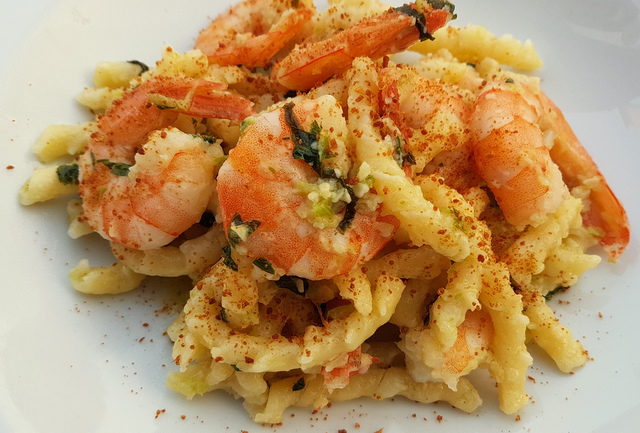
Ingredients:
- 400 g short or long busiate pasta (I used short busiate)
- 3 garlic cloves peeled
- 1 handful fresh basil
- 1 handful fresh parsley
- 2-3 celery stalks
- 100 g almonds
- 100 g bottarga (tuna roe) ready grated or grate yourself
- 1/2 glass white wine
- 2-3 tbsp extra virgin olive oil
- salt for pasta
- black pepper to taste
- 200 g prawns (preferably Mazzara)
- Put a large saucepan of water on to boil for the pasta. When it starts boiling, add salt and bring to the boil again.
- If the prawns are fresh, wash them well, remove the heads, veins and shell, leaving just the tail. (you can also use frozen prawns, preferably still with the tail. In this case just remove most of the shell)
- Chop the basil, parsley, celery, almonds and garlic finely. I used a food processor for the celery, almonds and garlic.
- But the mixture into a frying pan or skillet with the olive oil. Mix together and cook for 1-2 minutes.
- Add the prawns and cook for another 2-3 minutes. Add salt and pepper to taste. (I didn’t add salt as the bottarga is quite salty)
- Add the white wine and turn up the heat until the alcohol evaporates, then turn the heat off as soon as the prawns are cooked.
- Cook the pasta al dente in the boiling salted water. When the pasta is ready, save a cup of the cooking water and drain.
- Reheat the prawns with some of the pasta cooking water. Add the pasta and mix everything together well. If the sauce seems dry, add more pasta cooking water.
- Serve immediately with a generous sprinkling of bottarga.
If bottarga isn’t available, this recipe can be made without it or with another type of fish roe.
Busiate is a typical pasta from Sicily often eaten with seafood. However, this recipe can be served with different types of pasta. I would recommend spaghetti or linguine, or short pasta such as penne or fusilli
The best prawns in Sicily come from Mazara, however you can use other types of fresh or frozen prawns.
Reference:
https://www.the-pasta-project.com/pasta-with-bottarga-almonds-and-prawns/
Orecchiette with Braciole alla Barese - Orecchiette with beef rolls
from Bari in the Southern Italian region of Puglia (Apulia)
Ingredients:
- 320 g orecchiette pasta or short pasta of your choice
- 8-10 beef slices thinly cut top or bottom round roast or sirloin
- 8-10 slices Italian lardo or prosciutto crudo or pancetta (If using lardo keep some extra for the sauce)
- 2-3 garlic cloves peeled and finely choppes
- 1 handful fresh parsley chopped
- Parmesan or pecorino flakes (You can also use grated cheese)
- salt and pepper to taste
- 1/2 red chili pepper or peperoncino or chili flakes
- 1 red or yellow onion peeled and finely chopped
- basil leaves torn in pieces
- 500 g tomato passata rustica (this is a thick passata)
- cherry tomatoes (optional)
- 1/2 glass red or white wine (I used white)
- salt for pasta and to taste
- black pepper to taste
- 30 g grated pecorino or Parmesan for serving
- 3-4 tbsp extra virgin olive oil
- Peel and chop the onion. Wash and chop the parsley. Chop the red chili pepper (if using). Remove the seeds for less heat! Peel and finely chop the garlic. Cut flakes or slithers of the parmesan or pecorino. Cut pancetta or lardo into small thin slices (if using and not already sliced)
- Place a slice of beef on a work surface perpendicular to you. Use a meat tenderizer to flatten it until it is very thin without breaking it. (The thicker the meat the longer it will take to cook) Season with salt and pepper, and place a piece of lardo or prosciutto on the beef slice. Then add a little chopped garlic, chili pepper, parsley and some cheese flakes.
- Roll the beef up around the filling into a tight cylinder. Secure the roll with toothpicks. Repeat with the remaining beef and filling ingredients.
- Heat the olive oil in a Dutch oven or deep skillet over a medium-high heat. Add the chopped onion and extra lardo (if you are using it) and cook until the onion starts to soften and the lardo melts. Working in batches if necessary, add the beef rolls, and cook until browned on all sides. You will need to turn them. It takes about 6-8 minutes. (I did this part in a deep frying pan and then transferred everything to my Dutch oven.)
- Add the wine and cook until the alcohol evaporates.
- Add the tomato passata to the pan with some torn up basil leaves (I also threw in a few cherry tomatoes) and slat and pepper to taste. Bring to a boil. Reduce the heat to medium-low. Cook covered until meat is cooked through and tender, about 1.5-2 hours.
- You will need to stir occasionally to make sure the sauce isn’t sticking. If the sauce seems watery, uncover for the last 30 minutes to reduce. If it seems too thick add some water or even better some of the pasta cooking water.
- When the braciole is almost ready. Put a pot of water on to boil for the pasta. Add salt once it starts to boil and then bring to the boil again. Cook the orecchiette al dente according to the instructions on the packet. (I used ready made fresh orecchiette which took only 6 minutes to cook)
- Keep some pasta cooking water for the sauce if you think you need it. Drain the pasta.
- If you are serving the pasta, sauce and braciole together, remove the braciole from the sauce and mix in the pasta. You can add some saved pasta cooking water if you think your sauce is too thick.
- Remove the toothpicks from the braciole and serve together with the pasta putting 1 or 2 braciole on each plate (I like to cut them in half).
- If you want to serve the braciole separately to make 2 courses or meals out of this dish, remove the braciole and some of the sauce to another pot before adding the pasta to the remaining sauce.
- Serve the pasta with extra grated parmesan or pecorino as required.
This dish is traditionally served with orecchiette but other short pasta can be used. I would suggest fusilli, penne, Sardinian gnocchi (malloreddus) or casarecce.
This dish is traditionally served as 2 courses. The pasta with the tomato sauce and then the braciole as a main course with vegetables and bread. I like to eat it together as one plate meal
Reference:
https://www.the-pasta-project.com/orecchiette-with-braciole-alla-barese-beef-rolls/2/
https://www.the-pasta-project.com/orecchiette-with-braciole-alla-barese-beef-rolls/
Pasta con broccoli, salsiccia e bietole - Sicilian broccoli pasta with sausage and chard (silverbeet)
traditional Sicilian recipe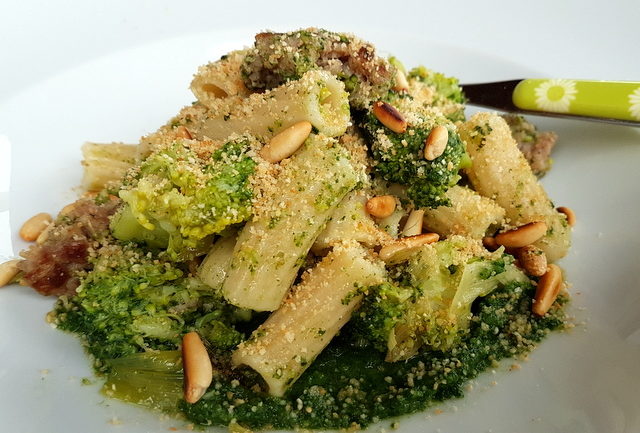
Ingredients:
- 400 g Tortiglioni pasta (14oz) or rigatoni, elicoidale or other pasta tubes. I used organic Sicilian ancient grain tortiglioni
- 300 g Italian pork sausage (10oz) with fennel if available
- 1-2 leeks finely chopped
- 1-2 heads broccoli (depending on the size)
- 1 bunch chard (silverbeet)
- 100 g pine nuts (3.5 oz)
- 100 g breadcrumbs
- 2-3 garlic cloves peeled and chopped
- extra virgin olive oil as required
- salt for cooking veg and pasta and to taste
- black pepper to taste
- 1 ice-cube
Method:
Prepare the ingredients
- Wash the broccoli and cut into florets. Wash the chard and remove most of the stalk. Peel and finely chop the garlic. Wash and finely chop the leeks. Remove the skin from the sausage. Chop the sausage meat.
Start cooking
- Cook the broccoli for just 4-5 minutes in a large pan of boiling salted water. Remove the broccoli with a slotted spoon but keep the water as you can use it to cook the chard and pasta.
- Finely chop the leeks and brown in a frying pan or skillet with a little of the olive oil. Add the broccoli to the leeks, stir and leave to simmer on a medium heat. Add a ladle or two of the broccoli cooking water as it starts to dry out.
- In a separate frying pan, dry fry the sausage meat until nicely browned. You don’t need to add oil as the sausages contain enough fat.
- In another frying pan, dry toast the pine nuts. When they are ready, put them into a bowl and then heat a little olive oil in the same pan. Add the garlic and cook until slightly soft. Toast the breadcrumbs with the chopped cloves of garlic.
- Add the sausage to the broccoli and stir. Season with salt and pepper. Continue to simmer for a little while. You can add a ladle or two more of the broccoli cooking water if it seems dry. As the broccoli and sausage cook you can break them up into smaller pieces if you want. (I kept them quite big)
- Blanch the chard in the broccoli cooking water and then remove the leaves from the water and blend in an electric blender with the ice and a little olive oil until well pureed. Keep aside.
Finish the dish
- Cook the pasta in the boiling broccoli cooking water. Once it is al dente, drain and add to the broccoli and sausage! Add half the chard puree and mix everything together well.
- Spread some of the remaining chard puree over the bottom of each plate. Place a serving of the pasta with broccoli and sausage on each plate. Sprinkle with toasted pine nuts and garlicky toasted breadcrumbs. Serve immediately.
Note:
This dish can be made with other types of pasta tubes.
You can also add a little peperoncino (red chili pepper) for a bit of kick! Add the peperoncino to the broccoli and leeks while cooking them together.
Reference:
https://www.the-pasta-project.com/sicilian-broccoli-pasta-with-sausage/
C
Pasta Cacio e Pepe - Cheese and pepper pasta
raditional recipe from the Eternal city, Rome and the Lazio region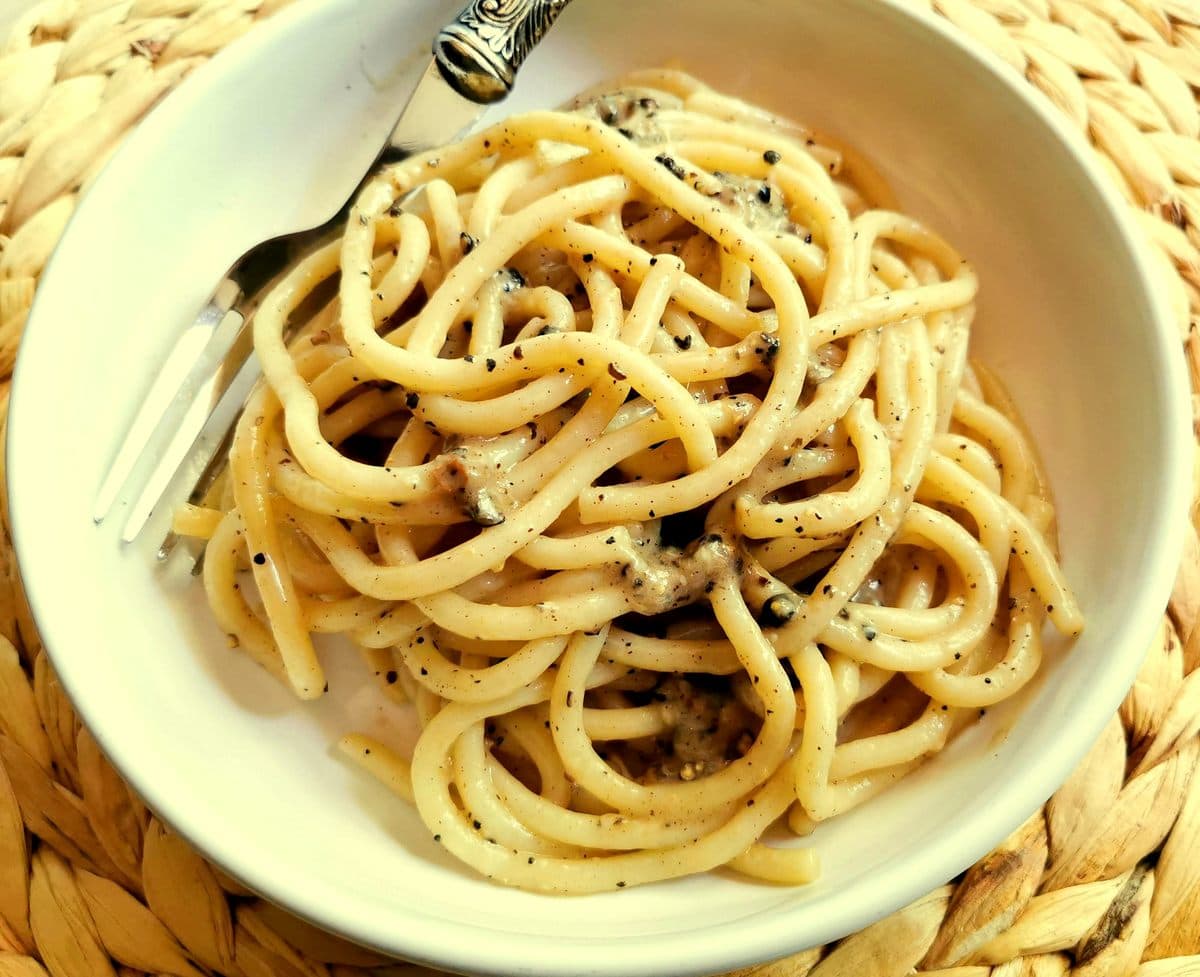
Ingredients:
- 400 g lombrichelli or tonnarelli (14oz) also made with spaghetti alla chitarra, bucatini or thick spaghetti
- 200 g Pecorino Romano cheese (7oz) freshly grated
- Freshly ground black pepper corns about 4 teaspoons Don’t grind too fine.
- Salt for boiling the pasta
Method:
- Dry fry the roughly ground pepper corns in a small frying pan until they start to release their aroma.
- Put a pot of water onto boil for the pasta. Use a bit less water than you would normally. Add salt once it starts to boil and bring to the boil again.
- Cook the pasta al dente according to the instructions on the packet. Take a ladleful of the pasta cooking water and add to the pepper corns. Then keep aside another cupful of the cooking water, drain the pasta and add it to the pan with the peppercorns. I drain the pasta 'wet' meaning it should still have some water with it. Mix the pasta with the pepper.
- Add the grated pecorino continue mixing very well until the cheese starts to become creamy.
- If too dry add a little more of the cooking water. If too liquid add more cheese.
- Serve on heated plates, topped with more grated pecorino and another generous sprinkling of pepper.
Alternative method:
- An alternative way to make the sauce is to put the cheese and most of the pepper in a large, heavy bowl or pan and beat in some of the pasta water very gradually to make first a paste, and then a sauce the consistency of bechamel.Add the pasta and toss well while adding more water if necessary, until you have a sauce that coats each strand of pasta. Don’t worry if it takes a while to come together – keep mixing and it should happen.It is also recommended to use less water than usual when cooking the pasta (about half), because this will result in cooking water that is rich in starch and will make it easier to obtain a creamy result.
Reference:
https://www.the-pasta-project.com/pasta-cacio-e-pepe/
Spaghetti con Capesante e Agrumi - Spaghetti with Scallops and Citrus Fruit
traditional Italian Christmas meal

Ingredients:
- 400 g spaghetti (14 oz)
- 12 fresh scallops (you can use frozen too)
- 2 oranges
- 1 lemon
- 100 g fresh cherry tomatoes (3.5 oz) or tinned cherry tomatoes
- 1/2 glass white wine
- 50 g capers (2oz)
- 50 g peeled almonds (2oz)
- salt for pasta and to taste
Method:
Make the pesto.
- Peel the lemons and oranges, being careful not to take the white part. (You can also just grate the zest off). Blend the citrus skins/zest in a mixer with the capers and almonds, some of the orange juice and a little extra virgin olive oil.
- If your scallops are fresh you will need to remove the white muscle (scallop) and the roe from the shell then wash well under running water. Remove any dirt or grit.
- Heat a little extra virgin olive oil in a pan, brown the scallops and roe (if using) for about 5 minutes over a low heat. Add the white wine, turn up the heat and allow the alcohol to evaporate.
- Move the scallops to the edges of the pan and place the tomatoes in the center. Add salt and sauté over a low heat for 15 minutes. Stir occasionally.
- In the meantime, bring a pot of water to a boil add salt and bring to the boil again. Cook the spaghetti al dente according to the instructions on the packet.
- Save a cup of pasta cooking water then drain the spaghetti al dente and add to the pan with the tomatoes and the scallops. Add the ‘pesto’ of citrus, capers and almonds to the spaghetti, mix everything together and sauté for a minute. If your sauce seems dry add a little pasta cooking water.
- Serve immediately.
This recipe is best made with spaghetti but you can used other long pasta like linguine or even short pasta like farfalle.
Reference:
https://www.the-pasta-project.com/spaghetti-with-scallops-italian-recipe/
Spaghetti Carbonara
Roman Cuisine
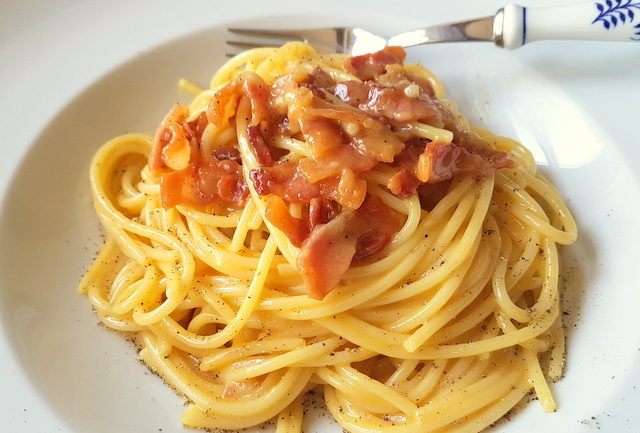
Ingredients:
- 400 g spaghetti or spaghettoni (14oz)
- 250 g guanciale (pork cheek) (9oz) or pancetta (Italian bacon) cut into small cubes.
- 2 tbsp olive oil (I don’t use olive oil with guanciale)
- 4 eggs (one per person) including one egg yolk or 5 eggs if using only egg yolks
- 50 g Parmigiano Reggiano (2oz) or aged pecorino freshly grated.
- freshly ground black pepper.
- salt for pasta
Method:
- Put a pot of water on to boil for the pasta. Add salt once it starts to boil. Cook pasta al dente according to the instructions on the packet
- Meanwhile, fry the guanciale or pancetta until browned. (I use a little olive oil with pancetta but not with guanciale as it renders quite a lot of fat)
- Lightly beat the eggs and/or egg yolks in a large bowl with the grated cheese and black pepper.
- When the pasta is ready, drain and add to the pan with the guanciale. Then mix well to coat the pasta. Take off the heat. Allow to cool slightly (so the egg won’t be scrambled).
- Then add the egg and cheese mixture. Stir well to coat the pasta, but not too vigorously ( you don’t want scrambled eggs!). Serve immediately with more grated cheese and black pepper as required.
As mentioned in the post, the majority of chefs agree that “true” carbonara has guanciale and not bacon or pancetta, although both make fine substitutes as long as they are quite fatty and cubed. Spaghetti is the usual pasta, although linguine, fettucine, bucatini and rigatoni can also be used.
Reference:
https://www.the-pasta-project.com/spaghetti-alla-carbonara/
Variations:
Carbonara with Cream: made by replacing 1 egg with 1 dl (about 1/2 cup) of heavy cream.
Spaghetti Tuna Carbonara
Smoked Salmon Carbonara:
Ingredients:
- 350 g (12 oz) of spaghetti
- 150 g (5,3 oz) of smoked salmon
- 4 eggs
- 70 gr (2,5 oz) of grated Parmigiano cheese
- 1/4 cup of cooking cream
- 1 orange
- 1/2 teaspoon of fresh or dried oregano
- salt
- a tablespoon of cognac (optional)
- Beat three whole eggs and one yolk with a pinch of salt, add the cream and the grated Parmesan cheese and mix well with a fork to obtain a smooth cream.
- Cut the smoked salmon into small pieces and place them in a bowl with a few leaves of fresh oregano broken by hand (or dried oregano), grated zest of half an orange and a little of its juice. For a more intense flavor, depending on your tastes, add a tablespoon of cognac. Let marinate the salmon about 15 minutes during which you will boil the spaghetti in salted water.
- Drain spaghetti when “al dente” and immediately add the beaten eggs cream on very hot spaghetti
- Finally add the salmon with its marinade. Mix well and serve.
Spaghetti alla carbonara di trota affumicata - Spaghetti with Smoked Trout Carbonara
from Lake Garda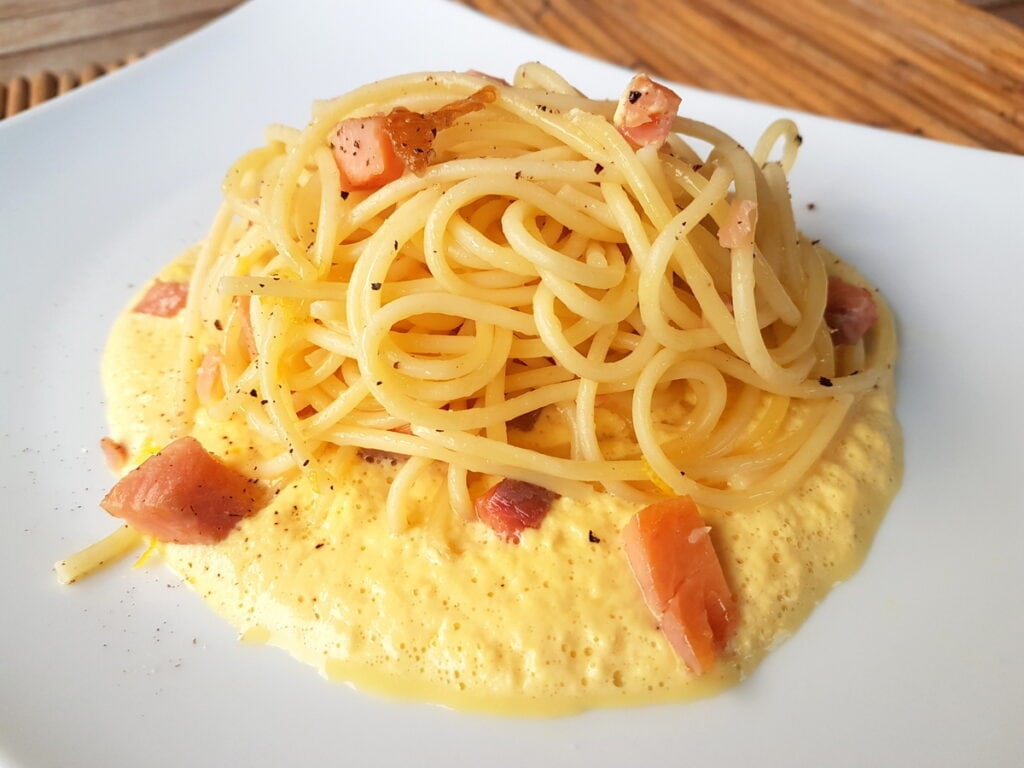
Ingredients:
- 320 g spaghetti (11oz) I used De Cecco
- 150 g smoked trout (5oz) (if possible cold-smoked)
- 2 eggs beaten
- 150 g fresh or cooking cream (5oz)
- 1 lemon for zest
- 50 g butter (2oz)
- salt for pasta and to taste
- freshly ground black pepper to taste
Method:
- Put a pot of water on to boil for the pasta. Add salt once it starts to boil.
- In a saucepan, reduce the cream slowly over a low heat to 50%, add the beaten eggs and cook them like you are making creamy scrambled eggs stirring all the time until the sauce starts to thicken. Emulsify with a hand blender.
- Remove the skin from the trout and cut it into small pieces and fry in butter until it starts to change colour.
- Cook the pasta al dente according to the instructions on the packet. Drain it and add it to the pan with the butter and trout. Mix together well with a sprinkling of grated lemon zest.
- Pour a little egg cream onto the bottom of each plate and pile the spaghetti and trout on top. Grate some lemon zest over each plate and a little black pepper. Serve immediately.
The original uses fresh trout or tench.
Reference:
https://www.the-pasta-project.com/spaghetti-smoked-trout-carbonara/
Pasta con tuna carbonara
a contemporary Italian recipe
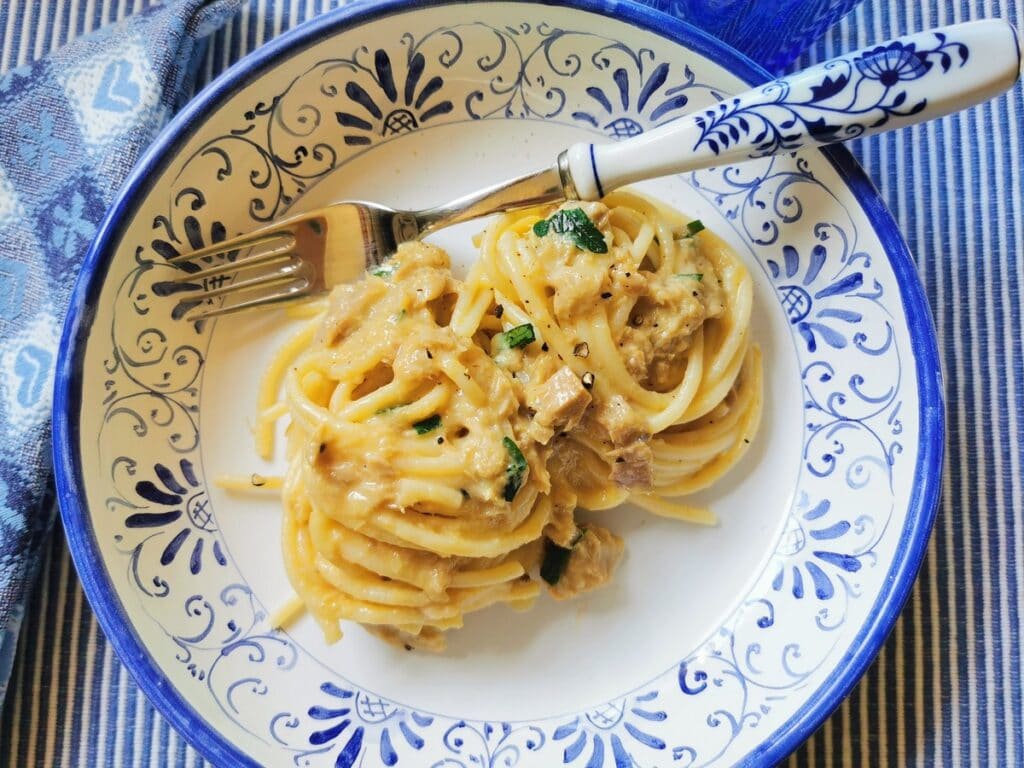
Ingredients:
- 400 g chitarrini or spaghetti (14oz) or any pasta of your choice
- 200 g canned tuna fillet (7oz) or normal canned tuna
- 60 g Parmigiano cheese (2oz) grated
- 2 garlic cloves peeled
- 2 eggs
- salt for pasta water and to taste
- ground black pepper to taste
- fresh parsley chopped (optional)
- 2-3 tbsp extra virgin olive oil
- Put a pan of water on to boil for the pasta. Add salt once it starts to boil and bring to the boil again. Cook the pasta according to the directions on the package.
- While the water is boiling and the pasta is cooking, beat the eggs with the Parmigiano cheese and a little ground pepper in a bowl.
- Heat the olive oil in a frying pan and cook the peeled garlic cloves until they brown. Add the tuna fillet broken into small pieces and cook for a couple of minutes. Remove the garlic cloves.
- When the pasta is ready, reserve 1 cup of the cooking water and drain the pasta.
- Add the drained pasta to the tuna, mix well and add some pasta cooking water. Cook for a couple of minutes then remove from the heat and add the egg mixture. Stir until the sauce becomes creamy.
- If the sauce is too dry, add a little more pasta cooking water and mix until you get a creamy consistency.
- Serve immediately with freshly grated pepper, chopped parsley (optional), and more grated Parmigiano.
Note:
For a thicker and richer sauce you can use 3 egg yolks instead of 2 eggs.
The eggs cook in the sauce like in traditional carbonara. But if you think they are too raw for you, return to the heat whilst mixing the pasta and sauce together. Just be careful not to scramble the eggs.
Reference:
https://www.the-pasta-project.com/pasta-with-tuna-carbonara/
Spaghetti alla Checca
from Rome
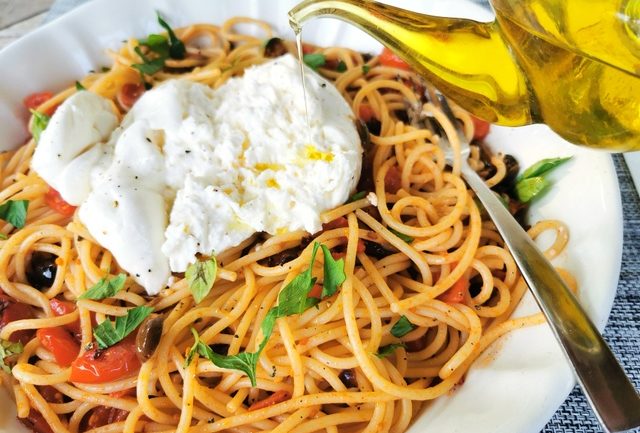
Ingredients:
- 400 g spaghetti (14oz) I used spaghettoni from pastificio Sorrentinno, Gragnano
- 400 g tomatoes (14oz) fresh and ripe. I used piccadilly tomatoes from Sicily
- 100 g pitted olives (3.5oz) I used taggiasca olives
- 1/2 tsp fennel seeds
- 1 handful fresh basil
- 1 handful fresh parsley
- 3-4 tbsp extra virgin olive oil
- 1 burrata (fresh)
- salt for pasta and to taste
- freshly ground black pepper. to taste
- Cut the tomatoes into cubes and leave them in a colander to naturally lose some of their water, without removing the inner flesh with the seeds.
- Chop the parsley and tear the basil leaves into pieces. Roughly chop the pitted olives.
- Put a pot of water on to boil for the pasta. Add salt once it starts to boil and bring to the boil again.
- Heat the olive oil in a frying pan or skillet. Let it heat gently, over a very low heat for about a minute. Add a tablespoon of chopped parsley, 4-5 chopped basil leaves and a pinch of fennel seeds and the olives
- After a minute, add the chopped tomatoes to the mixture. Stir, season with salt, cover and cook slowly, over low heat for 10-15 minutes.
- Turn off the heat and season with a generous amount of freshly ground pepper. Add some more chopped fresh parsley and basil. Let the sauce rest while you cook the pasta. It helps to enhance the flavours!
- Throw the spaghetti into the boiling salted water and cook al dente according to the instructions on the packet. When the pasta is ready save a cup of the cooking water and drain it.
- Add the pasta to the sauce while it is still very hot. If the sauce seems dry, add some of the pasta cooking water or another couple of tablespoons of oil. If using a serving dish as I did, turn the pasta alla checca out into a serving bowl and then add the burrata. Sprinkle with more fresh parsley and basil. Serve immediately!
You can use other types of pasta for this dish: pasta tubes such as penne, rigatoni, fusilli etc.
If you don’t have burrata you could use a fresh mozzarella, preferably di bufala.
For a dairy-free or vegan version leave out the burrata/mozzarella.
Reference:
https://www.the-pasta-project.com/spaghetti-alla-checca-recipe-from-rome/
Spaghetti alla Colatura – Italian Fish Sauce Pasta
from Cetara on Italy’s Amalfi coast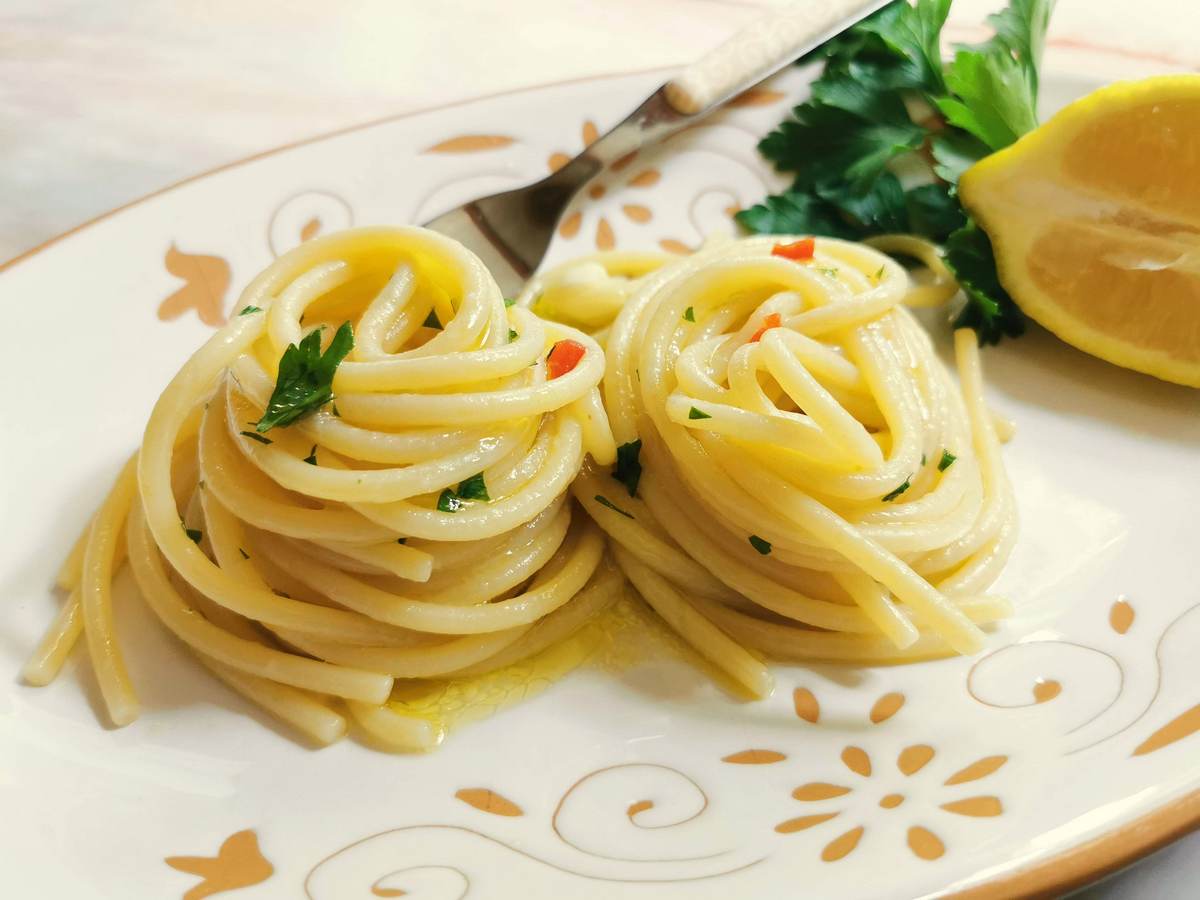
Ingredients:
- 400 g spaghetti (14oz) I used spaghettoni from Benedetto Cavalieri
- 45 ml colatura (3-4 tbsp)
- 1-2 garlic cloves peeled and crushed
- 20g fresh parsley chopped (1/3 cup)
- 1 tsp fresh peperoncino (red chili pepper) chopped or 1/2 tsp peperoncino flakes (optional)
- 5 tbsp extra virgin olive oil. more if required.
- 1 tsp salt for pasta or even no salt as colatura quite salty
Method:
- Put a pot of water onto boil. Add just 1 teaspoon salt or none (the colatura is quite salty). Add the spaghetti and cook al dente according to the instructions on the packet.
- Combine garlic, parsley and peperoncino in a large bowl. Slowly drizzle in the olive oil, followed by the colatura. Leave to rest until pasta almost cooked then add 2-3 tablespoons of the pasta cooking water to form an emulsion. Whisk well.
- When the pasta is ready, save some more cooking water and drain. Add the pasta to the bowl along with another 1/2 cup pasta cooking water. Toss and stir pasta to emulsify the sauce and coat the pasta. If the pasta seems dry, add more pasta cooking water, 1 tablespoon at a time, until it reaches the desired consistency. Add a little more colatura and mix again.
- Serve immediately!
https://www.the-pasta-project.com/spaghetti-alla-colatura-italian-fish-sauce-pasta/
Pasta con cozze alla Tarantina - Spaghetti with mussels alla Tarantina
from the province of Taranto, in Puglia (Southern Italy)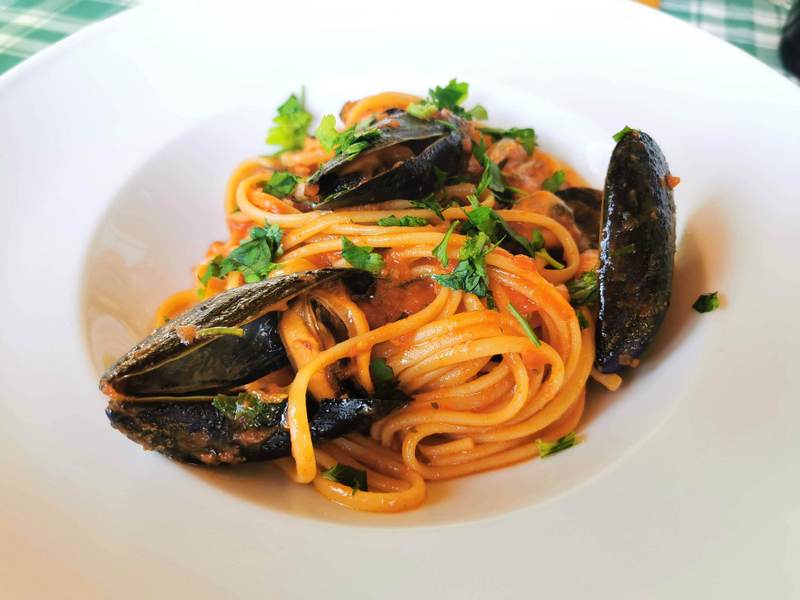
Ingredients:
- 1 kg fresh mussels (2.2lbs)
- 400 g spaghetti alla chitarra (14oz) or normal spaghetti or linguine
- 500 g small tomatoes (13.5oz) cut into quarters or 350 g tomato passata
- 1 tsp peperoncino flakes (red chilli pepper) or chopped fresh peperoncino
- 3 garlic cloves 2 chopped finely, 1 only peeled
- 4 tbsp extra virgin olive oil
- 1 handful fresh parsley chopped
- 100 ml white wine (3.5floz)
- salt for pasta and to taste
- ground black pepper to taste
Method:
- Wash the mussels well. remove all the debris on the shells with a wire brush and remove the beards.
- Put a deep pan or skillet on the stove with 2 tbsp. of olive oil, the peeled garlic clove and some chopped parsley.
- Warm the oil up a little, then add the mussels and the white wine. Allow the alcohol to evaporate then cover with a lid. Take the pan off the heat as soon as the shells have opened.
- Allow the mussels to cool down a little, then discard all the mussels that didn’t open. Keep 3-4 mussels per person in their shells and remove the other mussels from their shells. Filter the mussel cooking liquid and set aside.
- Put a pot of water on to boil for the pasta. When it starts to boil add salt.
- In a frying pan, sauté the chopped garlic and peperoncino flakes in 2 tbsp of olive oil, add the finely chopped tomatoes or tomato passata, a pinch of salt and a little pepper. Simmer over a low heat for 5-10 minutes.
- Add the all the mussels (with shells and without) and their filtered cooking liquid to the tomato sauce.
- Mix well and continue cooking over a low heat for a few minutes, until the liquid has reduced to a good consistency.
- Cook the pasta al dente according to the instructions on the packet.
- When the pasta is cooked, drain it and add it to the pan with the mussels and tomato sauce. Mix everything together well. Plate the pasta and mussels allocating a 3-4 mussels in their shells to each plate.
- Serve sprinkled with freshly chopped parsley.
This dish can also be eaten with bread instead of pasta. However, in that case, it’s better to leave most the mussels in their shells.
You can make this dish spicier by adding more peperoncino, depending on how spicy you like it!
Reference:
https://www.the-pasta-project.com/spaghetti-with-mussels-alla-tarantina/
D
E
Eliche alla crema di asparagi - Italian asparagus pasta
This Northern Italian asparagus pasta recipe is a delicious version of a typical Venetian way to combine asparagus with pasta.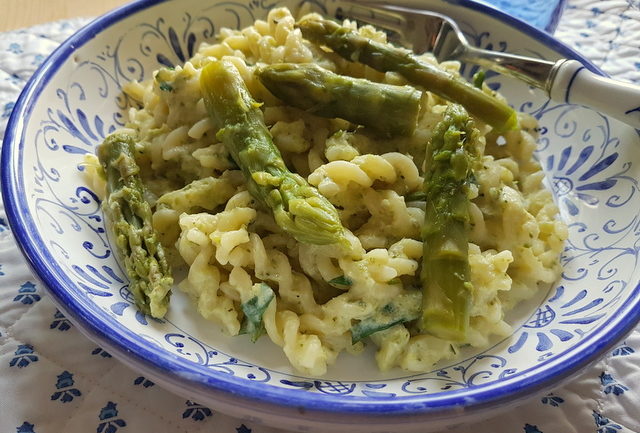
Ingredients:
- 320 g fusilli or eliche pasta (11-12oz)
- 400 g fresh green asparagus (14oz) washed and stalk ends removed
- 1 onion peeled and finely chopped
- 1-2 garlic cloves peeled
- 1 handful fresh parsley
- 1-2 zucchini
- 200 g robiola cheese (7oz) you can also use stracchino or cream cheese
- 50 g Parmigiano Reggiano (2oz) grated (for vegetarians use a hard cheese made without animal rennet)
- salt for pasta/asparagus and to taste
- black pepper to taste
- 4 tbsp extra virgin olive oil
- Peel the garlic and onion and chop the onion finely. Wash the asparagus and break off the hardest part of the stalks. Chop the parsley and cut the zucchini into small cubes.
- Heat the olive oil in a large frying pan or skillet ( big enough to hold the pasta and sauce later) Add the onion and garlic and soften for 5 minutes.
- Add the zucchini cubes to the garlic and onion with a ladle of water and a pinch of salt, mix and then cook covered over a moderate flame for 10 minutes.
- In the meantime, cook the asparagus in plenty of salted water for about 10 minutes (until al dente/ still a bit firm). When they are ready, drain them but keep the cooking water to be used to cook the pasta in.
- Now cut the asparagus in two, keeping the spears aside. Blend the asparagus stalks with a little of the cooking water in a food processor or blender. Put the blended asparagus in a bowl.
- Then blend the mixture of zucchini, onion and garlic. Mix the 2 sauces together in and return the sauce to the frying pan.
- Add the robiola, some of the Parmigiano (or other hard cheese) and most of the parsley. Mix everything on a low heat until the robiola has melted. Add salt and pepper to taste and some of the asparagus spears.
- You can make the sauce more creamy with a few tablespoons of the pasta cooking water once the pasta has been cooked if you want to.
- If necessary add more water to the asparagus cooking water and bring to the boil. Cook the pasta in this water until al dente according to the instructions on the packet.
- Drain the pasta and add it to the asparagus sauce. Mix the pasta and sauce together well and serve with the remaining asparagus spears, more grated cheese, black pepper and a sprinkling of chopped parsley.
This recipe can also be made with other short pasta such as penne.
If you can’t find robiola cheese you can also use stracchino or cream cheese.
Reference:
https://www.the-pasta-project.com/italian-asparagus-pasta-recipe-from-northern-italy/
Tuscan pici pasta all’etrusca - Tuscan pici pasta all’etrusca (with roasted asparagus and cherry tomatoes)
from Tuscany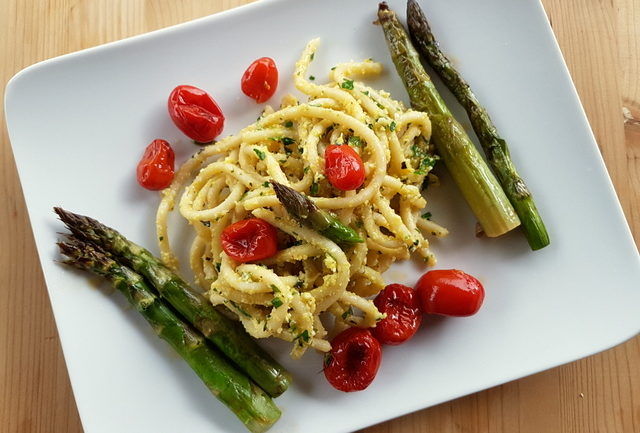
Ingredients:
- 400 g pici pasta
- 2 eggs hard boiled and peeled
- 3 garlic cloves peeled
- 1 handful fresh basil
- 1 handful fresh parsley
- 1/2 handful fresh mint
- extra virgin olive oil
- 50 g pecorino grated
- 500 g green asparagus
- 20 cherry tomatoes ( I used pacchino)
- 3 garlic cloves peeled
- extra virgin olive oil
- Hard boil the eggs, cool them in cold water and peel them. Cut the peeled eggs in half lengthwise. Remove one yolk and keep it aside.
- Boil some water in a saucepan for the pasta. Add salt once it starts to boil and bring to the boil again.
- Add the pici to the boiling water and cook al dente according to the instructions on the packet. Dried pici can take up to 18 minutes to cook. Save some of the cooking water before draining the pasta.
- Meanwhile, put the peeled garlic cloves, the egg whites and one yolk, the basil, parsley and mint leaves, grated pecorino cheese and a generous amount of extra virgin olive oil in a blender. Pulse a few times until the ingredients form a rough sauce. You may need to add more olive oil if it’s too dry.
- Add some ground pepper and salt to taste.
- Put the egg and herb mixture in a large bowl and add a little of the pasta cooking water to make it looser.
- Drain the pasta and add it to the sauce. Mix well and serve immediately with the remaining egg yolk crumbled on top and a sprinkling of pecorino and parsley.
- Wash the asparagus and tomatoes. Cut off the hard part at the bottom of the asparagus stalk. This is best done by bending the stalk until it breaks. It normally breaks in the right place!
- Put the veggies in an oven dish with 3 whole peeled garlic cloves and some olive oil and roast them for about 20 minutes in a pre-heated oven at 180°. (this can be done while the pasta is cooking)
- Serve with the Tuscan pici pasta all’etrusca.
If you can’t find pici and don’t want to make it yourself, this recipe can be made with other types of long pasta. I would suggest a thick spaghetti or bigoli, or perhaps even linguine.
Reference:
https://www.the-pasta-project.com/tuscan-pici-pasta-alletrusca/2/
https://www.the-pasta-project.com/tuscan-pici-pasta-alletrusca/
F
Spaghetti con fagiolini - Spaghetti with green beans
traditional vegetarian pasta dish form Puglia in Southern Italy
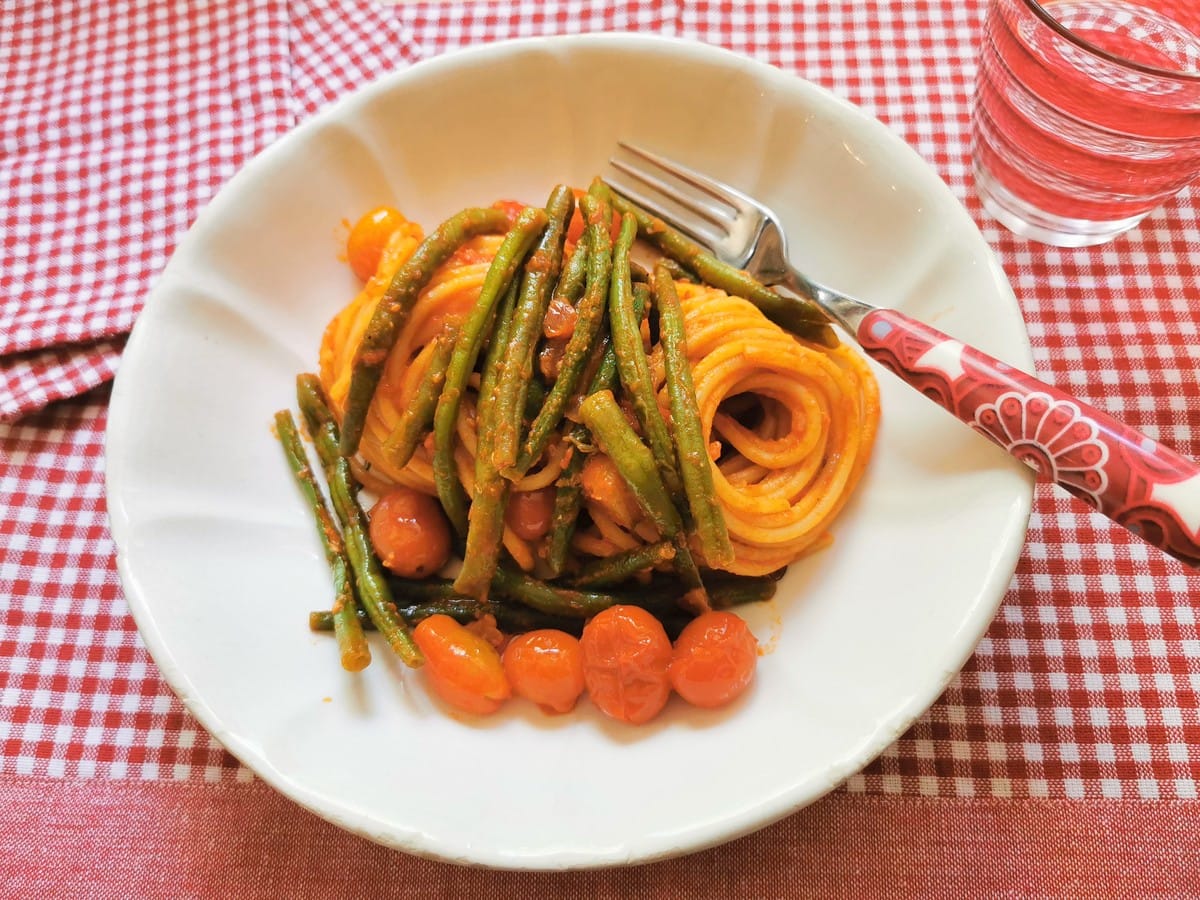
Ingredients:
- 400 g fresh green beans 14oz
- 400 g spaghetti 14oz
- 250 g ripe fresh tomatoes 9oz cut into quarters
- 200 g tomato passata 9oz less or omit if serving without pasta
- 1 garlic clove peeled
- 1 fresh or dried red chilli pepper/ peperocino optional
- 1 red onion
- 2 tbsp extra virgin olive oil
- cacioricotta or pecorino cheese grated
- salt for pasta water and to taste
- black pepper to taste
Method:
- Wash the green beans and cut off the thinner parts at each end. Peel and slice the onion very finely. Cut the tomatoes into halves or quarters depending on how big they are.
- Pour the oil into a large frying pan or skillet, heat it and fry the garlic clove, onion and whole peperoncino until the onion starts to soften. Then add the tomato pieces and cook until they start to soften too.
- In the meantime, in a pot with plenty of salted water, partly cook the green beans for a few minutes. Drain the beans and add them to the pan with the onion and tomatoes.
- Continue cooking for 5 minutes then add the tomato passata and mix everything together. Simmer for 10-15 minutes. Add salt and pepper to taste.
- When the sauce is almost ready, cook the pasta in plenty of boiling salted water according to the instructions on the packet. I used the water I cooked the beans in. If you are using fresh pasta the cooking time will be very short.
- Remove the garlic clove and red chilli pepper from the sauce. Drain the pasta and add it to the green beans and tomato sauce.
- Add a generous sprinkling of grated cacioricotta and mix well. I also added a handful of chopped fresh parsley or you can use basil. (both are optional)
- Serve with more grated cacioricotta or pecorino sprinkled on top.
Note:
You can also make this recipe with other types of pasta and if you can’t find the right cheese use any semi-hard ricotta or pecorino.
You can serve the beans and tomatoes as a side dish or use short pasta to make a pasta salad. For a side dish reduce or omit the tomato passata.
Leftovers can be turned into a delicious frittata (omelette)!
Reference:
https://www.the-pasta-project.com/spaghetti-green-beans/
Vermicelli pasta frittata
from Basilicata
Ingredients:
- 250 g Vermicelli pasta cooked or uncooked
- 8 eggs 2 per person
- 2 garlic cloves peeled and chopped
- 4-6 anchovy fillets (salted or in oil) chopped
- 1-2 teaspoons peperoncino flakes
- 1 handful fresh parsley chopped
- Salt and pepper to taste
- olive oil. extra virigin
- If you are using uncooked pasta, cook the pasta al dente in plenty of salted boiling water according to the instructions on the packet. Drain it and allow it to cool.
- Fry the chopped anchovies, peperoncino flakes and chopped garlic in extra virgin olive oil until the garlic starts to soften and the anchovies begin to melt. Don’t let the garlic brown.
- Add the garlic mixture to the cold pasta, along with the eggs and parsley, some salt and pepper. Mix everything together well.
- Pour the mixture into a large non-stick frying pan and fry, turn the frittata to cook the other side. Both sides should be nicely browned and slightly crispy.
- Serve immediately cut into slices with a sprinkling of parsley.
Note:
This recipe can be made with other types of long pasta such as spaghetti, bavette, linguine etc.
Reference:
https://www.the-pasta-project.com/vermicelli-pasta-frittata-basilicata/
Le tagliatelle ai funghi porcini - Tagliatelle with porcini mushrooms
from Tuscany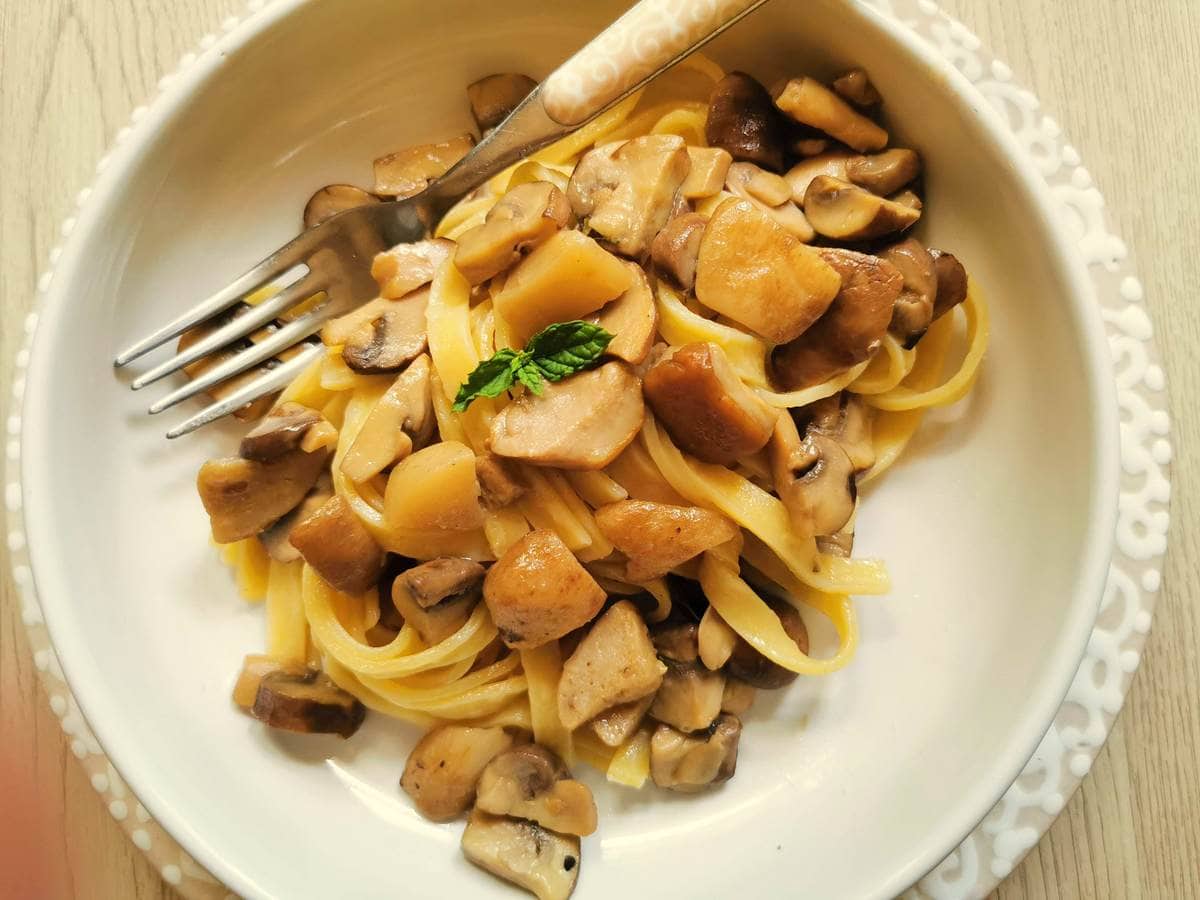
Ingredients:
- 400 g tagliatelle (14oz) fresh or dried
- 500 g fresh or frozen porcini mushrooms (17oz) or 250 g porcini and 250 g cremini. See recipe notes about using dried porcini
- ½ glass white wine
- 3-4 fresh nepitella small leafed wild mint sprigs or thyme or parsley
- 2-3 tbsp extra virgin olive oil
- 2 garlic cloves peeled
- 2 tbsp unsalted butter
- salt and pepper to taste and salt for pasta cooking water
- Parmigiano Reggiano grated or vegetarian parmesan (optional)
Method:
- Put water on to boil for the pasta. Add salt once it starts to boil.
- Clean the fresh mushrooms by cutting off the end of the stalk. It would be better not to rinse with water, given that the fungus absorbs it. You can use a small brush to remove any soil, or a damp cloth.
- Cut the mushrooms into pieces
- Fry the peeled garlic cloves in the olive oil, then remove them when golden and add the mushrooms.
- Cook them for about 3-4 minutes until they start to brown. If using frozen mushrooms add after the fresh ones have browned a little
- Add wine and nepitella or thyme, increase the heat and cook until the alcohol has evaporated
- Reduce the heat and add salt and pepper.
- Continue to cook for about another 10-15 minutes. Lower the heat once mushrooms are cooked through and add the butter. When the butter has melted remove the pan from the heat.
- Cook the pasta in salted boiling water, remove a glass of the pasta cooking water to be used later and then drain and add the pasta to the pan with the mushrooms and butter.
- Toss everything together over a low heat. The pasta absorbs liquid very quickly so if it looks too dry, add a little of the pasta cooking water at a time until you get the right creaminess.
- Serve immediately with grated parmigiano or vegetarian parmesan as required.
If you want you can also add peas to this recipe very easily after adding the wine.
Tagliatelle is the most traditional kind of pasta to go with porcini because it soaks up all the sauce well and fresh tagliatelle has a rich taste, but pappardelle or fettuccine will work too.
USING DRIED PORCINI. Because dried porcini have a very strong taste and are expensive, I would suggest mixing them with some cremini or white champignon/button mushrooms) That way you also get nice pieces of mushroom in the sauce. 60g (2oz) dried porcini & 400g (14oz) other mushrooms. Soak the dried porcini in a bowl of warm water for at least 30 minutes before draining and cooking. (the water should cover the mushrooms) You can use a bit of the soaking liquid in the sauce.
Reference:
https://www.the-pasta-project.com/tagliatelle-porcini-mushrooms/
G
Spaghetti alla gennaro (Toto pasta) - Spaghetti Gennaro
Neapolitan recipe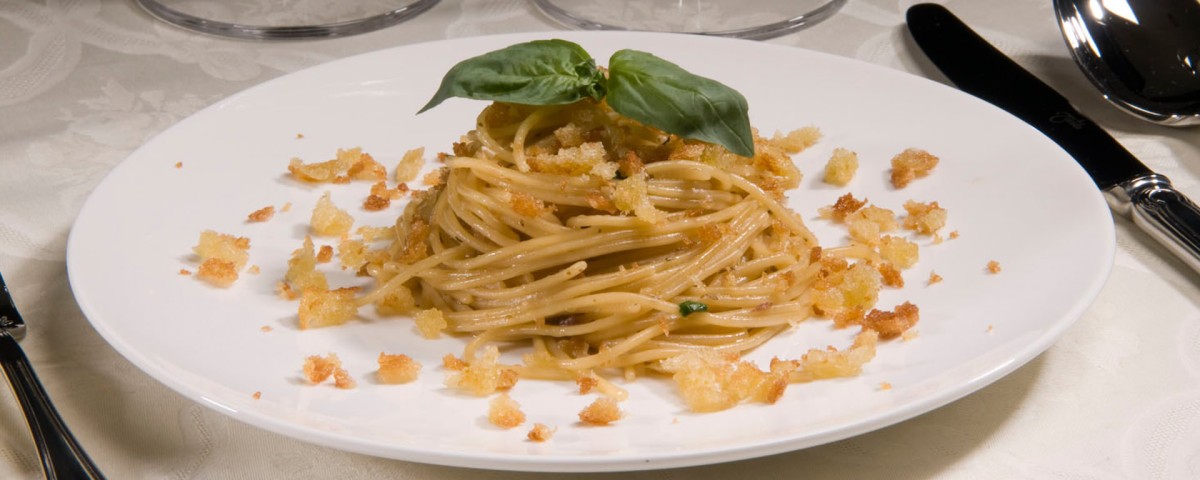
Ingredients:
- 11.5 oz Spaghetti
- 2 slices of stale bread
- 4 anchovies desalted
- Basil
- Oregano
- Garlic
- Extra virgin olive oil
Method:
- Rub the bread slices with garlic, then crumble them on a plate. In a pan, sauté the crumbled bread with two tbsp oil, two whole garlic cloves, making sure that the garlic does not brown too much.
- In another pan, pour the oil and the chopped anchovies and a pinch of oregano.
- Cook the spaghetti and drain al dente then pour into the pan with the anchovies, add the crunchy bread, a handful of basil torn by hand and stir.
- Serve immediately.
Reference:
https://www.academiabarilla.it/en/ricetta/spaghetti-gennaro/
Pasta alla Genovese
“La Genovese” (or Genovese sauce) is a typical Neapolitan meat sauce made with onions and beef, without tomatoes.
The meat is cooked long and slowly in the saucepan. It flakes together with the onion and becomes a flavorful and delicate meat sauce.
It’s perfect for seasoning pasta, especially Ziti or Paccheri with which the traditional Neapolitan recipe known as La Genovese or Pasta alla Genovese is made.
According to historical sources, in Aragonese times, the managers of some inns in the port area of Naples were originally from Genoa, a city in northern Italy (“Genovese” means “from Genoa”)
These cooks prepared a fabulous sauce made with meat and lots of onion, hence the name “genovese.”
Ragù Bianco - White Bolognese Sauce
It’s a pasta sauce made with ground meat and a soffritto of carrots, celery and onion, flavored with rosemary.
Ingredients
- Ziti or Paccheri
- 500 g (1 pound) of ground veal or ground chicken
- 1 medium carrot
- 1 celery stalk
- 1 medium onion
- 100 ml (2/5 cup) of dry white wine
- 300 ml (1 1/4 cup) of meat broth or vegetable broth
- 3 tablespoons of extra virgin olive oil
- fine salt and ground black pepper to taste
- 2 fresh rosemary sprigs
- 1 tablespoon of all purpose flour or cornstarch
Method:
Ragù Bianco - White Bolognese Sauce
It’s a pasta sauce made with ground meat and a soffritto of carrots, celery and onion, flavored with rosemary.
Ingredients
- 500 g (1 pound) of ground veal or ground chicken
- 1 medium carrot
- 1 celery stalk
- 1 medium onion
- 100 ml (2/5 cup) of dry white wine
- 300 ml (1 1/4 cup) of meat broth or vegetable broth
- 3 tablespoons of extra virgin olive oil
- fine salt and ground black pepper to taste
- 2 fresh rosemary sprigs
- 1 tablespoon of all purpose flour or cornstarch
Method:
- First clean and chop the onion, carrot and celery.
In a saucepan, sauté the vegetables with the extra virgin olive oil for about 2 minutes. Keep the heat on medium, taking care not to burn the soffritto. - Add the ground meat. Stir for a few seconds so that the meat is well combined with the vegetables and oil.
Then add a tablespoon of flour or cornstarch and mix very well. This is a little trick that will allow you to get a creamier meat sauce. - Raise the heat and add the white wine. Allow the alcohol to evaporate over high heat. Then reduce the heat to low.
Add the very hot broth until almost all of the meat is covered. - Also add 2 sprigs of fresh rosemary, which will give the white ragu sauce its characteristic flavor and aroma.
We recommend tying the rosemary sprigs with kitchen twine to prevent the needles from falling into the meat sauce. - Cover and simmer for at least 35 minutes, the time it takes for all the flavors to blend.
- Prepare the pasta.
- Then, for the last 10 minutes, cook over high heat without the lid to evaporate the liquid. Stir frequently, taking care not to let the sauce stick to the bottom of the saucepan.
This white Bolognese sauce should be thick and consistent without too much liquid.
At this point, adjust the salt and pepper and turn off the heat. The Ragù Bianco is ready! - Drain pasta and season with white ragu and a drizzle of oil to taste.
At this point, adjust the salt and pepper and turn off the heat. The Ragù Bianco is ready!
Fettuccine with White Ragu
Season fantastic homemade fettuccine with freshly made white ragu!
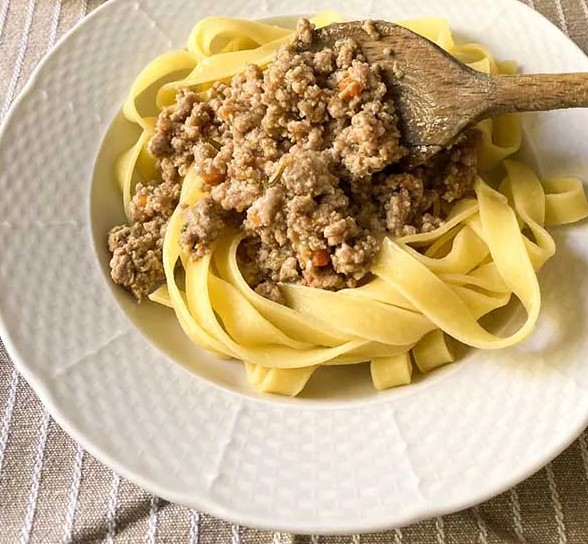
Reference:
https://www.recipesfromitaly.com/ragu-bianco-recipe/
Pasta alla Gricia
from Rome
This recipe was invented around 400 AD and was a typical dish served in the taverns of Ancient Rome.
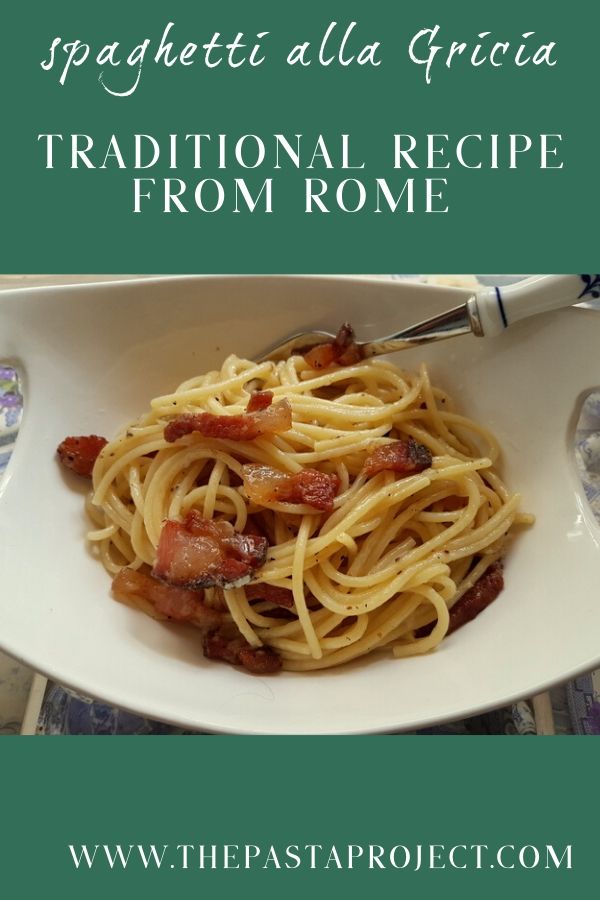
Ingredients:
400 g spaghetti or rigatoni (14 oz) I used spaghetti di Gragnano from Lidl’s Italiamo range.
200 g guanciale cured pork jowl (7oz)
150 g pecorino grated (5 oz)
salt for pasta
black pepper to taste
1-2 tbsp extra virgin olive oil
Method:
- Cut the guanciale into strips. Grate the pecorino
- Heat a frying pan or iron skillet and fry the guanciale in the olive oil until crisp and golden. Some people prefer not to let it get crispy as they like the fat to be soft. I prefer it crispy
- Put a pot of water on to boil for the pasta. Add salt once it starts to boil and bring to the boil again.
- Cook the pasta al dente according to the instructions on the packet. When the pasta is nearly cooked take a little water from the pot and add it a little at a time to the guanciale and stir over a low heat until the pasta is ready. This starchy water combines with the fat to form the ‘sauce’ for the pasta. Otherwise it will be too dry.
- Before draining the pasta, save some more of the pasta cooking water. When the pasta is cooked, drain it and quickly add it to the frying pan together with the pork jowl mix everything together well and cook for a minute over a medium heat.
- Remove from the heat, add half the grated Pecorino cheese and some ground black pepper. Mix well and serve immediately with a sprinkling of the rest of the grated pecorino.
Note:
This recipe is traditionally made with spaghetti or rigatoni.
Reference:
https://www.the-pasta-project.com/pasta-alla-gricia-recipe-from-rome/
H
I
K
L
Spaghetti al Limone with Ricotta, Basil and Lemon
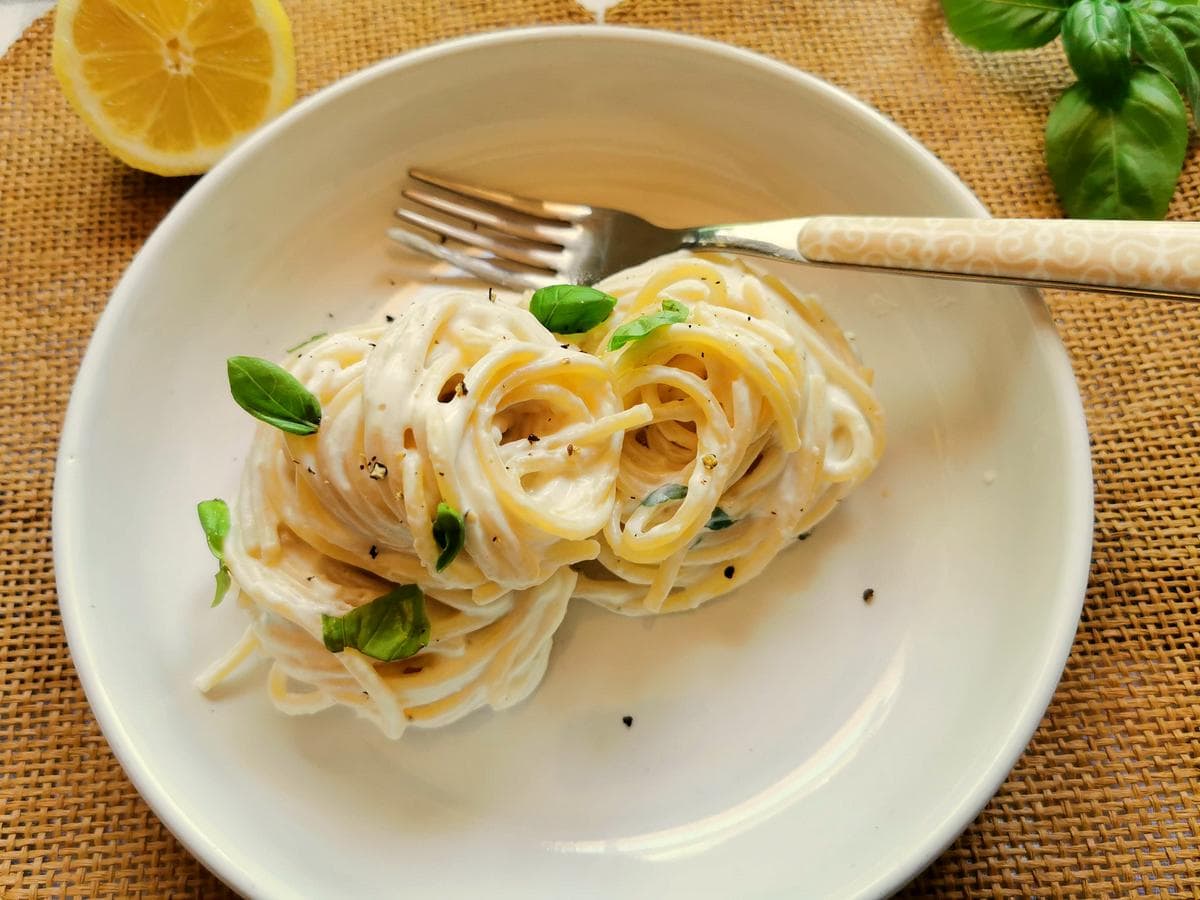
Ingredients:
- 400 g spaghetti (14oz) or tagliolini or linguine
- 400 g fresh ricotta (14oz) drained
- basil leaves handful
- 1 Organic lemon medium sized from Sorrento or Amalfi if possible or organic
- 100 g Parmigiano Reggiano (3.5oz) grated or vegetarian parmesan
- Salt and black pepper as required
Method:
- Mash the ricotta cheese in a bowl and then add the grated rind from the lemon (I used all the rind from one lemon), most of the basil leaves torn into pieces, a pinch of salt and a pinch of black pepper. Mix. (you can also use a blender)
- Add half the grated cheese to the ricotta and mix together well. If the sauce seems a bit thick, add a dash of milk. It needs to have the consistency of a dip.
- Cook the pasta al dente, in boiling salted water according to the instructions on the packet, reserve a large cup of the cooking water.
- Drain the pasta and return it to the pan or pour it into a bowl.
- Add the ricotta cream and half the saved cooking water to the pasta, a little at a time. Continue to mix well until you have a creamy sauce. If needs be, add some more of the pasta cooking water.
- Serve immediately with a sprinkling of ground black pepper, more grated Parmigiano (or vegetarian parmesan) and the remaining basil.
Note:
Variation: this recipe can also be made with mint instead of basil.
Vegetarians should use vegetarian parmesan as Italian Parmigiano is made with animal rennet.
Use gluten free pasta to make this recipe gluten free.
Use short pasta and serve this lemon pasta as a side dish with seafood.
Reference:
https://www.the-pasta-project.com/spaghetti-al-limone-ricotta-basil-lemon/
M
Spaghetti mare e monti
Pasta recipe from the Marche region in central Italy.

Ingredients:
- 400 g spaghetti (14oz) I used spaghetti from Pasta Mancini
- 400 g calamari (14oz) fresh or frozen
- 400 g mixed mushrooms (14oz) I used porcini (cep) finferli (chanterelles) cardoncelli and white champignon.
- 400 g cherry tomatoes (14oz) or datterini
- 1 clove garlic peeled
- 1/2 glass white wine
- 1 handful fresh parsley chopped
- salt for pasta and to taste
- 1 tsp peperoncino flakes (red chili pepper) (optional)
- 4 tbsp extra virgin olive oil
- Gut and wash the squid, chop the body and tentacles into smallish pieces. Clean and chop the mushrooms, keeping the pieces more or less to the same size. Wash and cut the tomatoes into halves or quarters. Wash and chop the parsley.
- Put a pot of water on to boil for the pasta. Once it starts boiling, add salt and bring to the boil again.
- Fry the mushrooms and calamari together in olive oil with the garlic.
- Once the mushrooms have softened, pour in the wine and when the alcohol has evaporated add the tomatoes. Add salt to taste. Lower the heat and simmer until the tomatoes have softened too. Remove the garlic clove when the sauce is ready.
- While the sauce is simmering, cook the spaghetti a bit less than al dente according tothe instructions on the packet. When the spaghetti is ready, save a small cup of the cooking water and drain.
- Add the saved pasta cooking water to the sauce and then add the drained spaghetti, some parsley and the peperoncino (if using). Mix and stir everything together until the spaghetti is ready to eat.
- Serve immediately sprinkled with more parsley.
This recipe calls for mixed mushrooms. So, you can use any combination that you like. I used a mix of foraged and farmed mushrooms. Porcini give a lot of umami flavour to any dish and I was lucky enough to find fresh porcini! However, you could also use frozen or dried. Dried porcini will need to be soaked for about 20-30 minutes in warm water before cooking them.
Reference:
https://www.the-pasta-project.com/spaghetti-mare-e-monti-recipe-from-le-marche/
Pasta alla Mediterranea
These are very often vegetarian or seafood pasta sauces, but also sauces to cook or serve fish with as well as chicken. The two constant ingredients in all these alla mediterranea recipes are olives, usually black but sometimes green too, and tomatoes.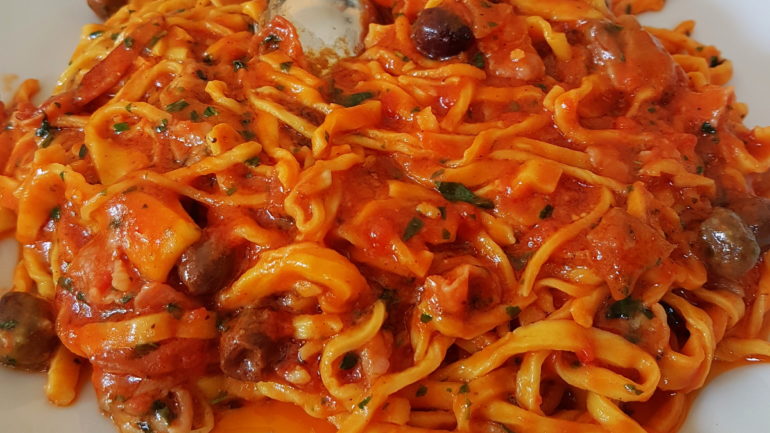
Ingredients:
- 400 g pasta of your choice We had tagliolini but any thin ribbon pasta or short pasta such as fusilli or penne can be used.
- 40 g anchovy fillets in oil
- 100 g tomato passata
- 100 g pitted black and green taggiasca olives you can use other types of olives too
- 20 g salted capers.
- 1 tsp peperoncino flakes optional
- 1 garlic clove peeled
- 4 tbsp extra virgin olive oil
- salt for pasta and to taste
- 1 handful fresh parsley chopped
- parmesan or grana grated (optional)
Method:
- Peel the garlic
- Chop the parsley
- Cut some of the olives into rings but leave a few whole.
- Drain and cut the anchovies into small pieces.
- Rinse the capers in water to remove the salt if you are using salted capers.
- Heat 4 tablespoons of extra virgin olive oil in a frying pan.
- Fry the whole garlic clove until it starts to brown slightly
- Add the chopped anchovies and stir to allow them to melt.
- Add the peperoncino (if you are using it) and cook for just a few seconds (you don’t want it to burn)
- Add the tomato passata/ polpa and the black and green olives.
- Add salt to taste and a pinch of pepper, and cook over a slow heat for about 20 minutes, stirring occasionally.
- Meanwhile, bring plenty of water to boil in a pot. Add salt when it starts to boil and bring to the boil again.
- Cook the pasta slightly less than the instructions on the packet.
- When the sauce is almost cooked, add the well-rinsed capers and parsley.
- Drain the pasta and add it to the pan with the sauce. Mix everything together well and cook for a further minute or two
- Serve immediately.
- For those who like it, the pasta can be eaten with grated parmesan or grana.
Note:
This sauce can also be served with grilled fish or used to cook white fish fillets in. Some people flour the fillets and brown them before adding the sauce and allowing the fish to finish cooking in it.
Reference:
https://www.the-pasta-project.com/alla-mediterranea-mediterranean-sauce-celebrations/2/
https://www.the-pasta-project.com/alla-mediterranea-mediterranean-sauce-celebrations/
N
Spaghetti alla Nerano - Spaghetti with fried zucchini
Nerano is a small town on the Sorrento peninsula (south of Italy).
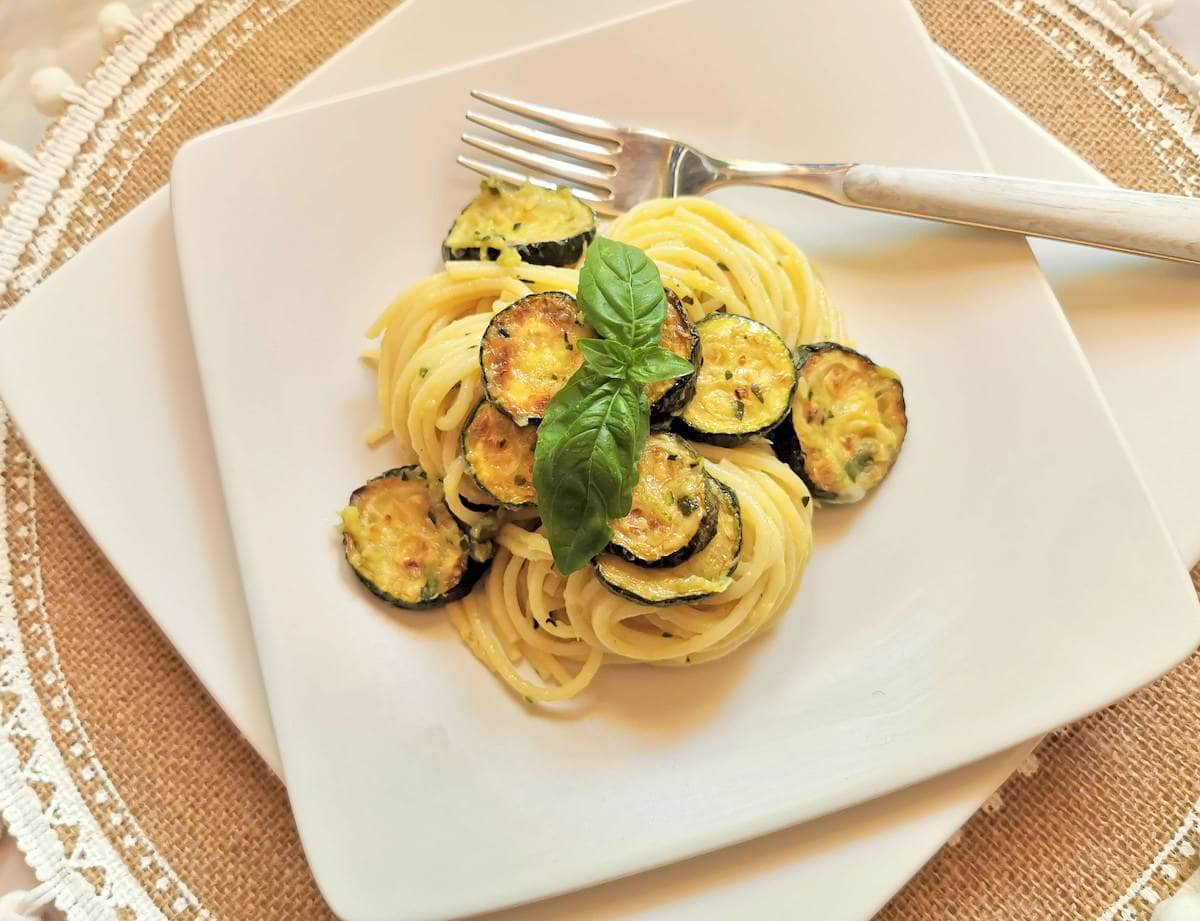
Ingredients:
- 400 g spaghetti (14oz)
- 700 g zucchini (24oz)
- olive oil extra virgin
- 2 cloves garlic peeled
- 100 g grated Provolone cheese (3.5oz) preferably Provolone del Monaco or caciocavallo (see notes)
- 1 handful fresh basil leaves. washed and torn into pieces
- salt for pasta and to taste
- pepper to taste
- Wash and cut the zucchini into thin slices, then fry them in extra virgin olive oil until browned.
- Once fried, put the slices on paper towels to remove the excess oil.
- Meanwhile boil the pasta in plenty of lightly salted water until al dente and drain, keeping aside a cup of the cooking water.
- Heat some more olive oil in a frying pan with the 2 garlic cloves and cook taking care not to burn the garlic.
- Immerse the zucchini slices in boiling water for 4 or 5 seconds, then cream 1/3 of them either by mashing through a sieve or briefly liquidizing in a food blender with some of the pasta cooking water.
- Remove the garlic and add the cream of zucchini and the zucchini slices to the pan and then stir in the cooked spaghetti. If the dish appears too dry add some of the saved pasta cooking water. Continue to stir over a low heat for a minute.
- Remove the pan from the heat, stir in the grated provolone until it starts to melt and become creamy. Season with a sprinkling of pepper and salt as required, Serve decorated with the basil leaves cut into pieces and some extra grated provolone to taste.
Spaghetti is the traditional pasta for this recipe but other long pasta such as linguine work well too. Although the original recipe I followed calls for Provolone del Monaco, this cheese isn’t available everywhere, However, there are other spicy provolone cheeses produced in Northern Italy and even in America which can be used instead. You can also use caciocavallo or parmigiano. Vegetarians should use a vegetarian parmesan or provolone.
Like many Italian pasta recipes there are slightly different versions of alla Nerano. Not all include creaming part of the fried zucchini and some add butter to the dish before serving.
Reference:
https://www.the-pasta-project.com/spaghetti-alla-nerano/
O
P
Pasta alla Papalina
from RomePasta alla papalina is a creamy pasta recipe from Rome named after Pope Pius XII, who was the inspiration behind its invention.
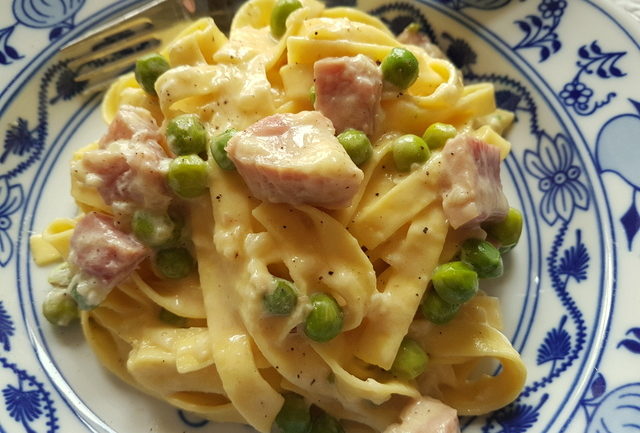
Ingredients:
- 400 g fettuccine or tagliatelle (14 oz) fresh or dried
- 1 small onion peeled and finely chopped
- 250 g peas (8-9oz) fresh or frozen
- 300 g cooked ham (10oz) or cured ham
- 200-250 ml heavy cream (1 cup)
- 2-3 eggs depending on size. If large use 2
- 200 g Parmigiano cheese (7oz) grated
- 1 knob butter or olive oil
- salt for pasta and to taste
- black pepper to taste
- Shell the fresh peas (if using), peel and finely chop the onion, cut the ham into small cubes/pieces, beat the eggs in a bowl with the grated Parmigiano.
- If using fresh peas you will need to cook them in a little boiling salted water for 10 minutes before draining and adding them to the sauce. Fresh peas take longer to cook than frozen.
- Put a pot of water on to boil for the pasta. Add salt once it starts to boil and bring to the boil again.
- Cook the finely chopped onion in the butter or olive oil in a skillet or frying pan until translucent. Add cooked ham or prosciutto, and allow that to cook for a few minutes. Then, add the peas and cook for a couple of minutes more. If using fresh peas and they seem a little hard, add a little water and cook for a bit longer.
- Then add the heavy cream (Italians use panna da cucina) and allow the cream to reduce a bit. Add ground black pepper and salt to taste.
- Cook the pasta al dente according to the instructions on the packet. Fresh pasta will need only 1-2 minutes. When cooked, drain the pasta (but keep it a little wet) and add it to the cream sauce.
- Then pour the beaten eggs and cheese over the pasta and sauce. Mix everything together well until the pasta is coated in a creamy sauce. Serve immediately, with generous sprinkling of ground black pepper and additional grated cheese if required.
Pasta alla Papalina is usually made with fettuccine but I also use tagliatelle. Although tagliatelle is slightly wider, there’s often no difference between these two pasta ribbons.
You can leave out the peas if you wish. The original recipe is said to be without peas. However, nowadays many Italian include them.
Reference:
https://www.the-pasta-project.com/pasta-alla-papalina-recipe-from-rome/
Pesto Alla Siciliana - Sicilian Pesto Pasta
from Sicily
Ingredients:
- 400 g ripe datterini tomatoes (14oz) or San Marzano or vine tomatoes. Peeled and chopped
- 100 g Parmigiano Reggiano or grana (3.5oz) Vegetarians should use a vegetarian cheese.
- 200 g fresh ricotta (7oz) Cow's or sheep's milk ricotta.
- 2 tbsp pine nuts
- 1 garlic clove peeled
- 1 bunch fresh basil leaves
- 2-3 tbsp extra virgin olive oil.
- salt to taste
- 400 g casarecce pasta (14oz) or other short pasta
Method:
Prepare the ingredients
- Wash and peel the tomatoes (see post for how to peel tomatoes) Cut them in half and remove most the seeds and liquid. You can also use unpeeled tomatoes if you prefer. Peel the garlic. Wash the basil leaves and pat them dry with kitchen paper.
Make the Sicilian pesto
- Add the tomatoes to your blender or food processor and pulse a couple of times. Then add the garlic, pine nuts and Parmigiano. Pulse again a few times. Then add the basil leaves and a little olive oil. Pulse in short spurts to avoid heating the blender and ruining the basil. If your sauce seems too liquid, add more grated cheese.
- Pour the pesto into a bowl and add the ricotta and salt to taste. Mix the ricotta in with a fork. Store your pesto in an airtight jar in the fridge for 2-3 days or use immediately.
Cook the pasta
- Put a pot of water on to boil for the pasta. Add salt once it starts to boil and bring to the boil again. Cook the pasta al dente according to the instructions on the packet. Homemade casarecce take about 10-15 minutes depending on the size you make them. Test taste before draining.
- Save a cup of pasta cooking water, drain the pasta and pour it back into the pot. Add the Sicilian pesto and mix well. If the sauce seems thick add some of the pasta cooking water. Serve immediately with more ricotta or grated cheese.
Note:
It’s a nice serving idea to keep back some of the fresh ricotta and add it to the pasta and pesto before serving.
Reference:
https://www.the-pasta-project.com/casarecce-pasta-with-sicilian-pesto/
Linguine con polipetti alla Luciana - Linguine with Baby Octopus alla Luciana
from Santa Lucia, Naples
Ingredients:
- 400 g linguine or spaghetti (14oz) I used linguine from èViva pasta
- 500 g baby octopus (17-18 oz) 5-8 octopus depending on size. I used musky octopus.
- 400 g tomato passata (14oz)
- 250 g datterini or cherry tomatoes (9oz)
- 2 garlic cloves peeled
- 2 tbsp black olives
- 1 tbsp capers
- 1/2 glass white wine
- 1 tsp peperoncino flakes (red chili pepper) optional
- 1 handful fresh parsley chopped
- salt for pasta and to taste
- ground black pepper to taste
- 4-5 tbsp extra virgin olive oil
Method:
- Carefully wash the baby octopus under running water and dry them. Peel the garlic. Wash and chop the parsley. Rinse the capers well if they are salted.
- Put the extra virgin olive oil into a Dutch oven or deep skillet add the peeled garlic cloves. Soften the cloves over a medium heat. Then add the baby octopus and cook them for 5 minutes. Turn them so they start to brown on each side.
- Turn up the heat. Add the white wine and cook until the alcohol evaporates.
- Add the black olives, capers and small tomatoes and cook for 2-3 minutes until tomatoes start to soften.
- Add the passata, salt and pepper to taste and peperoncino flakes (if using). Mix everything together well and cook over a low-medium heat covered for about 20 minutes, stirring occasionally (until the octopus is soft).
- Meanwhile, put a pot of water on to boil for the pasta. Add salt once it starts to boil and bring to the boil again. Cook the pasta al dente according to the instructions on the packet. When the pasta is ready save a cup of the cooking water and drain the pasta.
- If your cooking pot isn’t big enough, transfer the baby octopus and sauce to a warmed large bowl. Mix in some of the pasta cooking water if your sauce seems dry and then add the drained pasta. Mix everything together well. Serve immediately sprinkled with chopped parsley.
If you use fresh octopus, get your fishmonger to clean them for you. Otherwise you will need to open the head sac and wash out the guts. Then remove the beak and eyes.
Instead of small tomatoes and passata you can also use 400-600 g canned peeled tomatoes.
Traditionally, Neapolitan baby octopus alla Luciana is eaten either with spaghetti or linguine, or as a starter with crusty bread.
Reference:
https://www.the-pasta-project.com/linguine-with-baby-octopus-alla-luciana/
Polpette di tonno fresco con pasta - Sicilian Fresh Tuna Meatballs with Pasta
from Sicily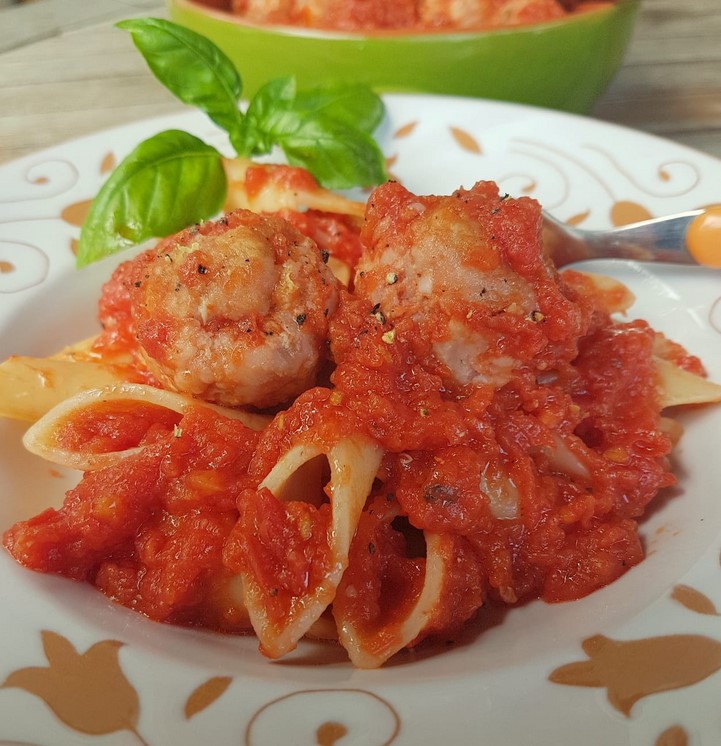
Ingredients:
For the tuna meatballs
- 400 g fresh tuna
- 1 onion (medium size or half a large one) peeled and finely chopped.
- 1 egg
- 3-4 tbsp breadcrumbs or grated pecorino
- 3-4 fresh mint leaves
- 1 tbsp pine nuts chopped
- extra virgin olive oil for frying
- salt to taste
- ground black pepper to taste
- 2 tsp lemon zest (use an organic lemon)
- all purpose flour to coat tuna meatballs
- 500 g tomato passata (puree) or chopped tomatoes (17oz) or 1.5 kg peeled sauce tomatoes (3.5 lbs)
- 10 fresh basil leaves
- 2 garlic cloves peeled
- salt to taste
- ground black pepper to taste
- 1-2 tbsp extra virgin olive oil
- 400 g pasta tubes (14oz) or spaghetti. I used genovesone from pastificio dei campi
- salt for cooking water.
Method:
Make the fresh tuna meatballs
- Peel and finely chop the onion. Wash and chop the mint leaves. Grate the lemon zest. Chop the pine nuts.
- Cut the tuna first into slices (if it's one piece) and then into strips. Cut the strips into small pieces and then either mince in a food processor or chop with a knife like chopping parsley.
- Once you have cut all the tuna into small pieces, place it in a bowl and knead it a little with the back of a spoon so as to crush it a little more. (This isn't necessary if you used a food processor) Add a little salt to the tuna, plus the chopped onion, chopped pine nuts, mint and the lemon zest.
- Mix everything and then add the egg and breadcrumbs (or grated pecorino). Mix again.Best using your hands. Take a tablespoonful of tuna and work it with your hands into a round ball. Repeat until you have used up all the meatball mixture. The size isn't so important but try to make them all more or less the same for even cooking.
- Once all the meatballs are ready, take a frying pan and pour in enough olive oil to cover the bottom and start to heat the oil. Put the flour on a plate, roll the tuna meatballs in the flour and then fry them in the pan with the oil. Turn them so they brown on all sides. They don't need to be cooked through just browned. In this way, the surface of the meatballs will seal and your meatballs will remain soft while cooking in the sauce. When the meatballs are all browned transfer them to drain on some kitchen paper.
- Put a pot of water on to boil for the pasta. Add salt once it starts to boil and bring tothe boil again. Cook the pasta al dente according to the instructions on the packet.
- While the water is boiling and the pasta is cooking make the sauce. Put a tbsp. of olive oil in a skillet or frying pan, add the two peeled cloves of garlic. Once they start to soften add the peeled tomatoes or passata/polpa.
- Dilute the tomato sauce with a cup of pasta cooking water, add the basil leaves and cook for about 5 minutes. (fresh peeled tomatoes make take longer to break down. passata or polpa are ready faster).
- At this point, add the tuna meatballs and cook them in the sauce for another 10 minutes, turning them halfway through cooking.
- Drain the pasta. Return it to the pan or put it in a warmed bowl. Mix it well with some of the tomato sauce. You want to coat the pasta with sauce. Then plate the pasta and add 2-3 fresh tuna meatballs and more sauce. Serve immediately.
Traditionally Sicilians eat these delicious fresh tuna meatballs as an antipasto without the sauce or as a main course with just bread or potatoes.
These tuna meatballs can be made with swordfish instead or a mix of tuna and swordfish. You can use spaghetti or other types of pasta tubes such as penne, short ziti, paccheri or mezze maniche.
Reference:
https://www.the-pasta-project.com/sicilian-fresh-tuna-meatballs-with-pasta/
Spaghetti al pomodoro - Spaghetti with tomato sauce
an iconic Neapolitan recipe that dates back to the early 1800s and has been a symbol of Italian cuisine ever since.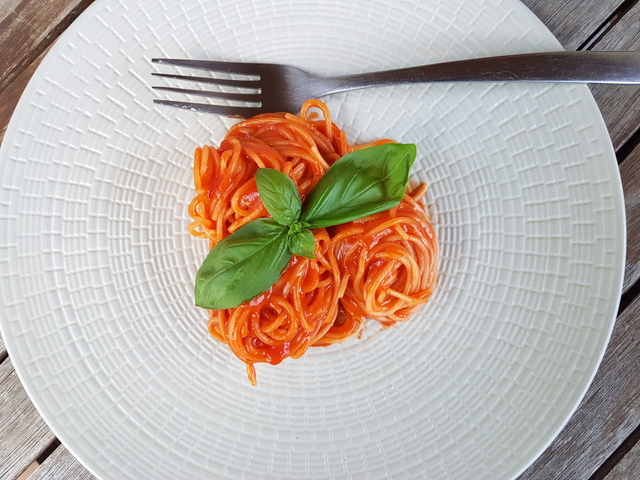
Ingredients:
- 360 g spaghetti (12-13 oz) I used spaghettini from Pastificio dei Campi
- 2 garlic cloves peeled
- 600-700 g ripe date tomatoes (21-24 oz) You can also use canned whole date tomatoes or San Marzano tomatoes. see notes
- salt to taste
- fresh basil as required
- 2-3 tbsp extra virgin olive oil
- Parmigiano or vegetarian/vegan cheese for grating) grated (optional)
- Blend half of the whole tomatoes and pass through a sieve to remove the skin and seeds. Then crush the other half using a fork and pass through the sieve as well. You will obtain a fairly watery tomato sauce but it will thicken while cooking.
- Peel the garlic and cook in the olive oil until it starts to soften. Add the tomato sauce and cook for about 5-10 minutes over a medium heat.
- Add the uncooked spaghetti to the sauce. Be careful not to try to stir too roughly as the spaghetti may break. Once it softens you can then cook like risotto stirring frequently.
- The starch from the pasta will thicken the sauce. If it gets too dry add a little water. Cook until the spaghetti is al dente. Add salt to taste and serve immediately with some fresh basil leaves and grated cheese if required.
- You can cook the spaghetti for 4-5 minutes in a pot of boiling salted water and then drain and add it too the tomato sauce. Finish cooking the pasta in the sauce. Keep a bit of the pasta cooking water to use if you need more liquid.
If you are using canned tomatoes just pour the contents of the cans (tomatoes and juice) through a sieve. Use a fork or your hands to break the tomatoes into small pieces so almost everything goes through the sieve.
If using larger types of tomatoes like San Marzano, it’s better to peel the tomatoes first by immersing them in boiling water and then removing the skins. Then blend half the tomatoes and pass the other half though a sieve.
Reference:
https://www.the-pasta-project.com/best-spaghetti-tomato-sauce-ever-la-devozione/
Vermicelli di Positano
vegetarian/vegan pasta dish from Positano on the Amalfi coast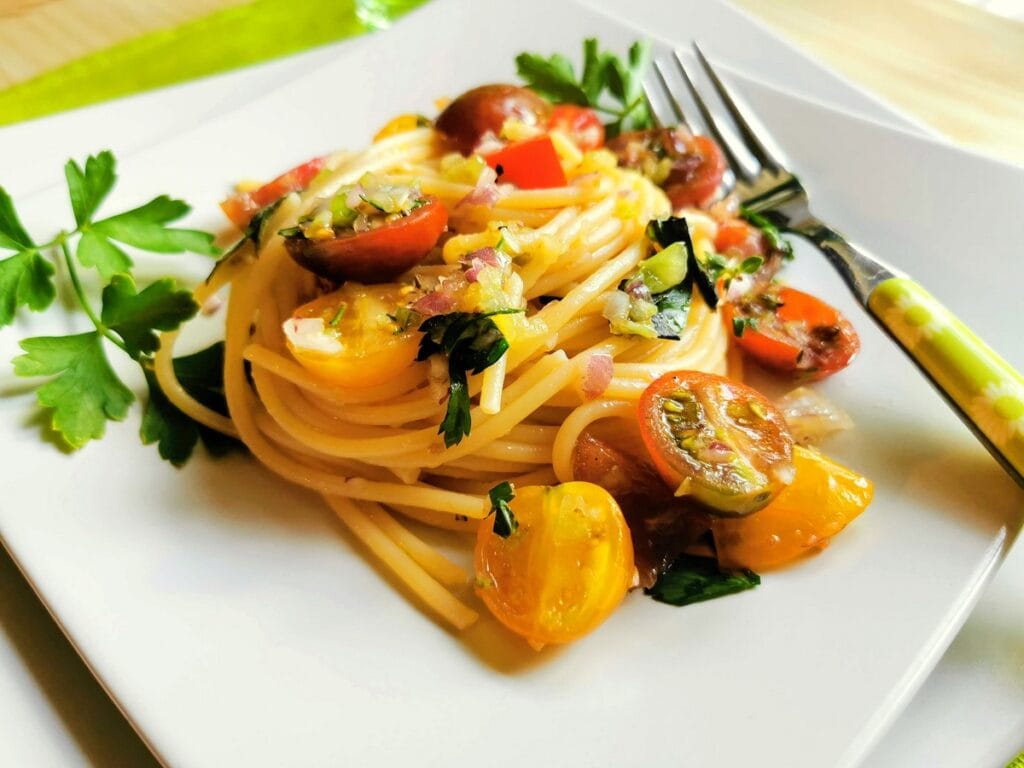
Ingredients:
- 400 g vermicelli (14oz) or spaghetti
- 500 g mature small tomatoes (1.1lbs) Red or different coloured datterini or cherry tomatoes
- 1/2 onion peeled and finely chopped
- 2 garlic cloves peeled. 1 finely chopped
- 2 celery stalks finely chopped
- 1 cup fresh parsley finely chopped
- 1/2 cup basil leaves finely chopped
- 1 teaspoon dried oregano or 2 sprigs fresh oregano
- 4-5 tablespoons extra virgin olive oil.
- salt for pasta and to taste
- black pepper to taste
- Chop the onion, celery and one garlic clove very finely (I put them in a hand-held food processor) Cut the tomatoes in halves or quarters. Chop the fresh herbs
- Rub the other garlic clove onto the sides of a large bowl that can also accommodate the pasta when it’s cooked.
- Put the tomatoes and chopped vegetables into a large bowl. Add the herbs.
- Add salt and pepper to taste and the olive oil. Mix everything together well.
- Cover with cling film and leave to marinate for an hour or 2 (not in the fridge). I prefer to leave it for at least 2 hours.
- Put a pot of water on to boil for the pasta. Add salt once it starts to boil and bring to the boil again.
- Cook the vermicelli al dente according to the instructions on the packet. (normally 13 minutes)
- As soon as the pasta is cooked, drain it and add it to the bowl with the tomato mixture and a little more olive oil if it seems dry. Mix everything together well.
- Serve immediately sprinkled with a little more chopped parsley.
You can also make this recipe with other types of long pasta such as spaghetti, linguine, tagliolini etc.
Reference:
https://www.the-pasta-project.com/vermicelli-di-positano/
Q
R
Pasta ricotta Siciliana - Sicilian Ricotta Pasta (2 ways)
from Sicily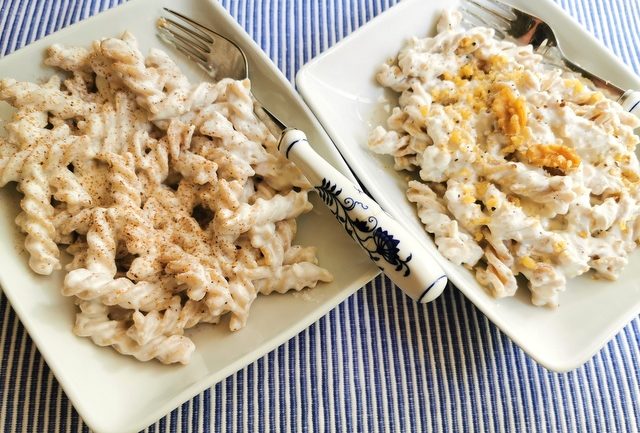
Ingredients:
- 400 g fusilli (14oz) or other short pasta. I used organic wholewheat fusilli from Benedetto Cavalieri
- 300 g fresh ricotta (10-11oz) I used cow's ricotta.
- salt for pasta and to taste
- ground black pepper to taste
- 1/2 tsp nutmeg grated
- 50 g walnuts (2oz) chopped or other nuts of your choice
- 1 tbsp extra virgin olive oil.
- 1 garlic clove peeled and finely chopped
- 50 g Grana Padano or Parmigiano Reggiano (2oz) grated. Vegetarians should use vegetarian cheese
Method:
- Put a pot of water on to boil for the pasta. Add salt once it starts to boil and bring to the boil again. Cook the pasta al dente according to the instructions on the packet. When the pasta is ready save a cup of the cooking water and drain.
- While the pasta is cooking, mix the ricotta with some grated nutmeg and ground black pepper in a bowl. Add a pinch of salt and a little bit of pasta cooking water to soften the ricotta (this is best done after the pasta has been cooking for 5 minutes or is cooked). Cream using a fork or handheld blender.
- Add the drained pasta to the ricotta, mix everything well and serve. If the pasta is too dry, add a little more cooking water. Serve with grated parmigiano or grana if required.
- Put the walnuts, chopped garlic and olive oil in a food processor and pulse a few times til walnuts are granular but not too fine. Add this walnut mixture to fresh ricotta instead of the nutmeg in step 2.
These ricotta pasta recipes can be made with short pasta tubes or even spaghetti.
Reference:
https://www.the-pasta-project.com/sicilian-ricotta-pasta-2-ways-with-nutmeg-or-walnuts/
Rigatoni pasta alla Parmigiana (alla Siciliana)
vegetarian rigatoni pasta from Southern Italy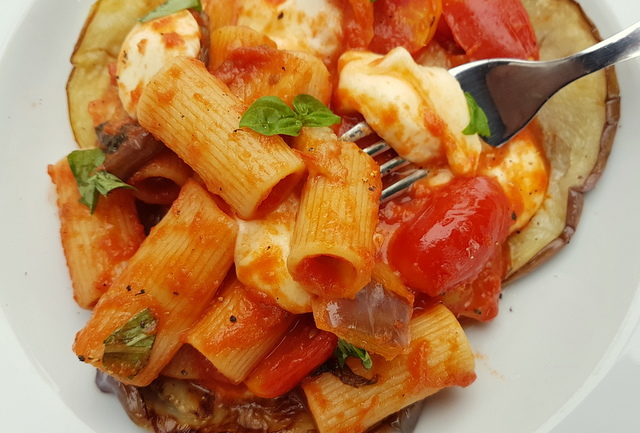
Ingredients:
- 400 g rigatoni pasta (14oz) or other short pasta
- 200 g fresh mozzarella (7oz) fior di latte
- 500 g eggplant ( I used 2 large round ones) (17oz)
- 600 ml tomato passata (20 floz) or 12 cherry tomatoes and 400 ml passata
- 1 handful fresh basil chopped
- 2 garlic cloves peeled
- 50 g Parmesan grated
- salt for pasta and to taste
- black pepper to taste
Method:
Prepare the eggplant
- Cut the eggplant into thick slices and cover with sea salt in a colander. Leave them for about 30 minutes. Rinse off the salt and pat dry with kitchen paper.
- Fry the eggplant slices in hot olive oil until they are quite golden on each side. Set aside on kitchen paper to allow most of the oil to get absorbed by the paper. Then cut most of the slices into cubes/pieces, leaving one or two slices per person intact. Keep these warm.
Prepare the tomato sauce and mozzarella
- Cut the cherry tomatoes into halves (if using). Drain and cut the mozzarella into small cubes/pieces. Peel the garlic cloves.
- Heat 2-3 tbsp olive oil in a deep frying pan or skillet. Add the garlic and cook until it starts to soften. Add the cherry tomatoes cook them for a minutes then add the passata and chopped basil. Stir well and leave to simmer for about 20 minutes. Stirring occasionally. Season with salt and pepper. Then remove the garlic.
Cook the pasta
- In the meantime, put a pot of water on to boil for the pasta. Add salt once it starts to boil. Bring to the boil again and add the pasta. Cook the pasta al dente according to the instructions on the packet. When the pasta is ready, save a cup of the cooking water and drain.
Finish the dish
- If the tomato sauce seems too thick add some of the saved pasta water and stir. Add the eggplant pieces to the tomato sauce. Mix together well and then add the drained pasta. Mix again and add the mozzarella pieces. Cook for a bit over a low heat until the mozzarella starts to melt slightly.
- Put one or two whole eggplant slices onto a plate. Place a serving of the pasta on top of the eggplant slices. Serve immediately with a sprinkling of chopped basil and grated Parmesan.
This recipe can be made with other short pasta tubes such as penne or tortiglioni.
You can finish this dish off in the oven. Put the pasta mixed with the tomato sauce, eggplant pieces and mozzarella pieces in a greased oven dish. Cover the top with more mozzarella slices (if you want) and grated Parmesan. Bake in a preheated oven at 180° until the top is browned and crispy.
Reference:
https://www.the-pasta-project.com/rigatoni-pasta-alla-parmigiana-recipe/
S
Pasta Salsiccia E Cavolo - Sausage and Cabbage Pasta
from the northernmost Italian region of Trentino-Alto Adige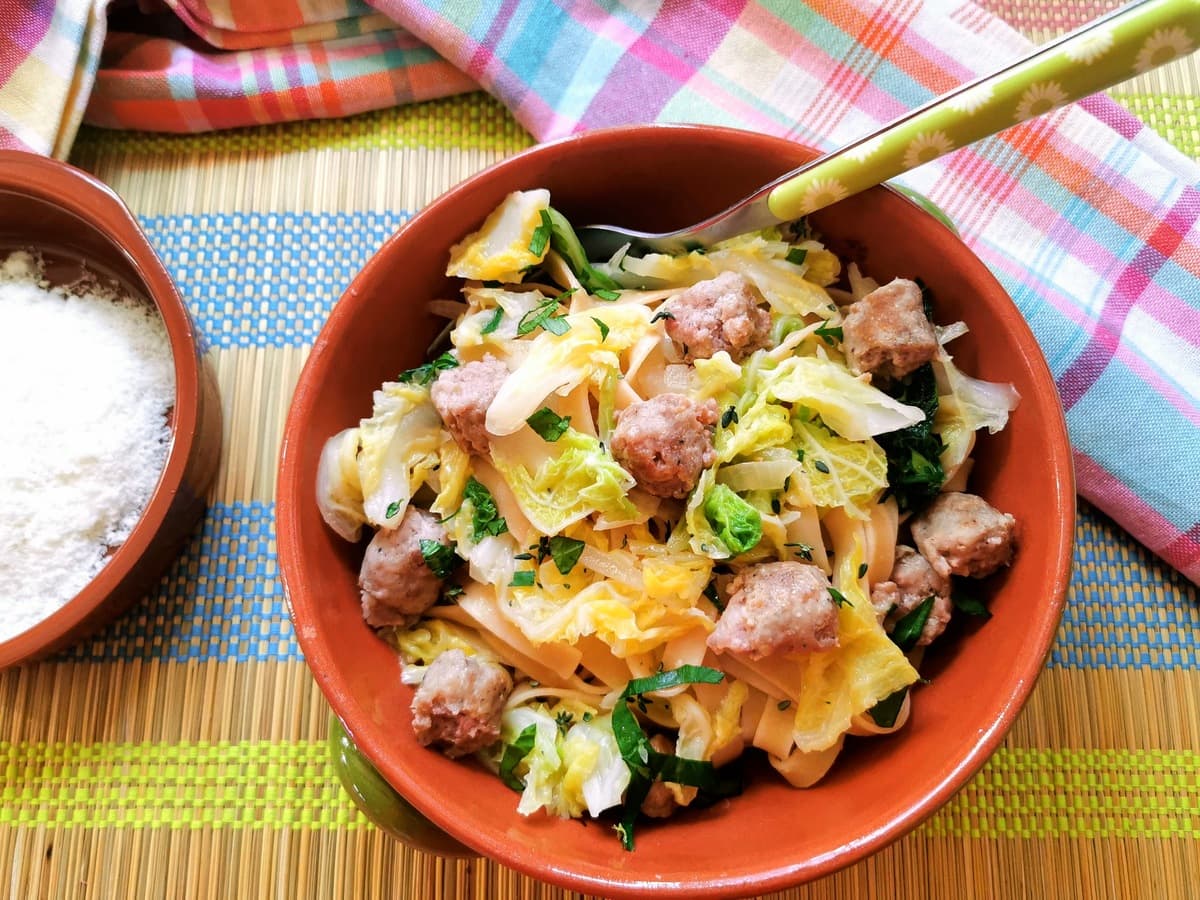
Ingredients:
- 14 oz tagliatelle pasta (400g) or other pasta of your choice
- 7 oz luganega sausage (200g) or other Italian pork sausage.
- 10.5 oz savoy cabbage (300g) washed and cut into slices
- 1 onion peeled and sliced
- 4 tbsp Parmigiano Reggiano grated
- 2-3 tbsp extra virgin olive oil.
- 1 cup vegetable broth
- 1 tbsp fresh herbs (parsley, thyme, marjoram) chopped
Method:
Prepare the ingredients
- Separate the cabbage leaves, wash them and cut into slices. Remove the casing from the sausages and cut into bite-size pieces. Peel and chop the onion. Wash and chop the herbs.
- Brown the sausage pieces in a large frying pan with a little olive oil. Then remove and set aside. Cook the cabbage for 3-5 minutes in boiling salted water then drain. You can keep the water for the pasta if you remove the cabbage with a slotted spoon.
- Sauté the onion in the same pan you used for the sausage. You may need to add more olive oil. When the onion starts to soften add the cabbage.
- Add the vegetable broth and braise the cabbage and onion for 10 minutes.
- While the cabbage is braising in the frying pan, cook the pasta al dente in the boiling water you cooked the cabbage in before. Drain the pasta when it's ready.
- Add the sausage back to the pan with the cabbage. Add salt and pepper to taste. Mix together then add the cooked tagliatelle and the fresh herbs. Mix again.
- Finally sprinkle the sausage, cabbage and pasta with grated Parmigiano. Mix again and serve immediately.
You can use other greens instead of the cabbage such as kale or spinach. The latter is better wilted in the pan with the sausages instead of preboiled.
You can also use other types of Italian pork sausages for this recipe. But, it’s better if they are slim sausages. Unlike other sausage pasta recipes, the sausage meat isn’t crumbled after removing the casing. Instead, you need to just cut into small bite-size pieces.
This recipe calls for wholewheat tagliatelle but other types of tagliatelle are good too or even other pasta ribbons or tubes.
Reference:
https://www.the-pasta-project.com/sausage-and-cabbage-pasta/
Pasta con sarde e finocchietto selvatico - Sicilian pasta with sardines and wild fennel
traditional Sicilian pasta recipe that dates back to 800 AD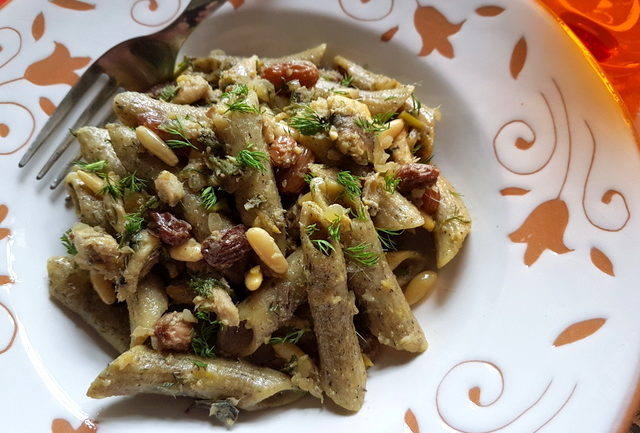
Ingredients:
- 400 g pasta (14 oz) I used organic penne from Sicily
- 400 g fresh sardines (14 oz) or canned
- 2-3 anchovy fillets
- 2-3 bunches wild fennel or fennel tops and fennel seeds
- 1 onion peeled and finely chopped
- 3-4 tbsp extra virgin olive oil
- 1 tsp saffron threads or powder
- 50 g raisins (2oz)
- 30 g pine nuts (1oz)
- salt for pasta and to taste
- ground black pepper to taste
Method:
- First, soak the raisins in a bowl of warm water. Then soak the saffron in a small cup along with 3-4 tbsp warm water.
- Wild fennel is very easy to find in Sicily. But, if you don’t have wild fennel use the greenest and most tender parts of fennel tops. Remove the lower part of the wild fennel stalks and cook in boiling salted water for 10 minutes. Save the water and drain the fennel and put it into a bowl of iced water to preserve the colour.
- If you have fresh sardines, rinse them thoroughly and eliminate the scales by rubbing the body under running water. Open the stomach and discard the entrails. Finally, pull firmly and gently on the head to separate the meat from the backbone. Rinse the fish fillets again, dry them, and place in the fridge until ready to cook.
- Put a pot of water onto boil for the pasta. You can add the fennel water to it. Add salt once it starts to boil (less salt if using the fennel water) and bring to the boil again.
- Peel and chop the onion finely. Drain the fennel and chop it. Then put the onion in a frying pan or skillet with 3 tbsp of olive oi and the anchovy fillets. Sautè over a medium heat until the onions are translucent and the anchovies have melted.
- Rinse the raisins and add to the pan along with the pine nuts, saffron and the minced fennel. Cook 5 minutes more, then add the sardine fillets. Sautè 3-4 minutes stirring until the fish starts to fall apart. Do not overcook the fish.
- Finally, add salt as needed and another splash of olive oil.
- Cook the pasta al dente according to the instructions on the packet. Drain and mix with the sardine sauce. Serve immediately with toasted breadcrumbs if required.
Note:
The traditional pasta for this recipe is bucatini or spaghetti. However, many people use penne or other pasta tubes.
Many Sicilians dress this dish with toasted breadcrumbs which is a traditional addition to seafood pasta dishes instead of cheese.
You can make this dish with normal fennel tops and canned sardines if you don’t have wild fennel or fresh sardines available.
Reference:
https://www.the-pasta-project.com/sicilian-pasta-with-sardines-and-wild-fennel/
Spaghetti allo Scoglio - Seafood Pasta

Ingredients:
- 350 g (12 oz) of spaghetti
- 1 kg (2 pound) of clams with shells
- 1 kg (2 pound) of mussels with shells
- 300 grams (2/3 pound) of squid
- 300 g (2/3 pound) of shrimps
- 200 g (1/2 pound) of ripe cherry tomatoes
- 1 fresh hot chilli pepper
- 2 cloves of garlic
- 5 tablespoons of extra virgin olive oil
- 150 ml (1/2 cup ) of dry white wine
- a bunch (1/3 cup) of fresh parsley
- salt to taste
- Rinse clams under running water and then let them soak in plenty of cold water with a handful of coarse salt.
The clams should remain in the cold water for at least an hour, preferably two, to purge. Keep this time in mind when you decide to make this recipe.
Place the clams in a pan and cook over high heat covered with a lid. Wait for them to open, this will take about 3 minutes. - Now strain the clam sauce with a fine strainer but DO NOT throw away their water, keep it aside.
Finally shell the clams, keeping some clams with their shells that you will use for the final decoration of the dish. - Clean the mussels by scraping off any impurities with the blade of a small knife. Tear off the byssus, that is the bearded part that comes out of the shell. Then, with the help of a stainless steel sponge, clean well their shells.
Place the mussels in a pan and cook over high heat covered with a lid. Wait for them to open, this will take about 3 minutes.
We prefer to cook clams and mussels separately in case the clams release a lot of sand. - Now strain the mussels sauce with a fine strainer. Finally shell the mussels, keeping some of them with their shells: you will use them for the final decoration of the dish.
- Wash the squid under running water, then remove the entrails, the eyes, the central beak and the internal bone.
- Finally remove the skin and cut them into rings. Set aside.
- Clean the shrimps, taking care to remove the dark filament, all the shell and the heads. Set aside.
Now that you have prepared and cleaned all the seafood, let’s see how to make the sauce for the spaghetti allo scoglio. - Wash and chop the cherry tomatoes then chop the parsley. Set aside.
- In a large saucepan, sauté the peeled garlic cloves in the extra virgin olive oil. Add the red hot chili pepper and the squid. Cook for about 2 minutes over medium heat.
- Then raise the heat and add the white wine. Stir and allow the alcohol to evaporate. Finally add the mussels and clams and lower the heat.
- Add a ladle of clams water and then the chopped tomatoes. Mix and cook over high heat for about 10 minutes.
- Finally, add the shrimp and chopped parsley. Cook over medium heat for about 3 minutes (shrimp have very short cooking times).
Italian seafood sauce is ready. Remove the garlic cloves and chili pepper (see note below). - Now cook the pasta. Bring plenty of salted water to a boil. Cook the spaghetti according to the cooking times described on their packaging. Using a slotted spoon, drain the spaghetti 3 minutes before the end of cooking time.
- Place them directly in the pan with the seafood sauce. Stir and finish cooking the spaghetti in the pan for another 3 minutes over high heat. This way they will better absorb the flavor of the seafood sauce.
Stir well and transfer the best Spaghetti allo Scoglio you have ever eaten to a serving dish. Garnish with the shells kept aside and serve.
About garlic and hot chili peper
We chose to leave the garlic and hot chili pepper whole. This way you can easily remove them from the sauce. If you prefer, though, you can chop them up and leave them in the sauce, depending on your taste.
A more Intense flavor
If you are using whole shrimp and not just the tails, you may want to use the heads to add more flavor to the sauce.
Add the heads immediately at the beginning of the preparation along with the garlic cloves so they have time to release all their flavor into the sauce. Remove them before serving the pasta.
Spaghetti allo Scoglio in Bianco (Without Tomatoes)
Spaghetti allo scoglio “in bianco” – that is without tomato – is a very popular variant in Italy.
The recipe is exactly the same as the one we described without the addition of cherry tomatoes or tomato sauce.
This variation maximizes the flavor of the seafood, so fresh fish is a must for a more intense flavor.
We recommend slightly increasing the amounts of oil, parsley and clam water to get a little more sauce in which to finish cooking the pasta.
Pasta alla Pescatora
The main difference is the type of fish used: in “Scoglio” there are no fish (such as sea bass, swordfish, sole for example) as in Fish Ragu recipe. In “pasta allo Scoglio” there are only molluscs, crustaceans, mussels and clams.
In “Pescatora”, instead, there are no molluscs with shell.
In both recipes, the essential thing is that the sauce is made with mixed fish/seafood, not just one type.
As we said, tomato is optional, the choice of the type of pasta as well, even though in the most common version they use spaghetti or linguine.
Reference:
https://www.recipesfromitaly.com/spaghetti-allo-scoglio/
Seafood Linguine al Cartoccio - Seafood Linguine in foil packets
Central-Southern Italian recipe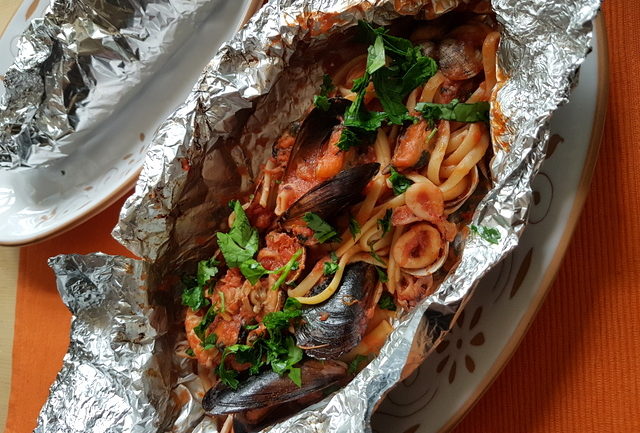
Ingredients:
- 320 g linguine (12oz) or spaghetti
- 250 g fresh mussels (9oz)
- 250 g fresh clams (9oz)
- 200 g fresh shrimps or prawns (7oz)
- 200 g small squid (7oz)
- 8 fresh scampi (2 per person)
- 300 g tomato pulp (10 oz) or peeled sauce tomatoes
- 3 garlic cloves peeled and finely chopped
- 2 shallots peeled and finely chopped
- 1 handful fresh parsley finely chopped
- 1/2 glass brandy or white wine
- salt to taste
- 3-4 tbsp extra virgin olive oil
Prepare the seafood
- Clean the mussels well, scrub and rinse them under running water and remove the ‘beards’. Discard any that are broken or open.
- Wash the clams in cold water and remove any that are open or with broken shells. Some kinds of clams need a lot of rinsing if they have sand in them. But you can also filter the liquid after you have precooked them, so don’t worry so much about the sand.
- Clean and prepare the fresh squid. Pull the tentacles away from the body. The tentacles, head and innards should separate easily from the body. Remove the quill from inside the body and discard. Clean the body by running it under a tap or cleaning it in a bowl of water.
- Remove the ‘ears’ from either side of the squid body and remove the skin with your fingers. (optional we don’t do it with very small squid)
- Cut the tentacles just below the eyes, be careful not to cut the ink sac which is located near the innards. Remove the ‘beak’ at the base of the tentacles. Discard the head, innards and ink sac (although the latter can be used for squid ink pasta!)
- Cut the squid body into rings and the tentacles into small pieces if you want to use them.
- Wash the prawns/shrimps. Remove the head, legs and main body shells from some of them, leaving the tail. Also remove the vein along the peeled prawns’ backs. but keep some intact. They impart a better flavour and make the dish look more attractive.
- Wash the scampi. We didn’t peel them but just cut along the scampi undersides to make opening them easier.
- Put the clams in a deep frying pan and cook covered over a medium to high heat until they have opened. (about 5 minutes). Do the same for the mussels separately.
- Allow the shellfish to cool a little and then remove the meat from most of the shells keeping some intact. Discard the empty shells and then filter the liquid that the clams and mussels have produced through a muslin cloth or very fine filter. Don’t discard it and keep the 2 separate.
- Chop the peeled garlic, the peeled shallots and the parsley finely.
- Put a pot of water on to boil for the pasta. When it starts to boil add the pasta. You probably don’t need salt as the seafood will already be a little salty.
- Heat the olive oil and the chopped garlic cloves and shallots in a large deep pan, add the squid, scampi and prawns and cook for 5 minutes, then sprinkle with the wine/ cognac and let the alcohol evaporate. We used cognac and flambéed it! But that is optional!
- Add the tomato pulp or peeled tomatoes and cook for about 10 minutes. Add the mussels and clams (shelled and with shells) and continue cooking for 3-5 minutes. To prevent the sauce from drying out too much, add some of the previously filtered cooking juices from the clams first and then the mussels. (The clam juice tends to be more flavourful)
- Preheat the oven to 200°c (about 390°F).
- Cook the pasta less than or half the time for al dente according to the instructions on the packet. Then drain it.
- Add the drained pasta to the pan with the sauce, mix well and place a single portion of pasta and seafood on a rectangular double sheet of baking paper or aluminum foil about 50cm long. Close each packet well and bake in your preheated oven for 8-10 minutes.
- Serve your seafood linguine al cartoccio sprinkled with parsley in the individual foil packets. Of course, you could put it into a plate but half the fun is eating it out of the ‘cartoccio’. Remember to provide napkins, finger bowls and a bowl to put the shells etc.
This recipe can be made with linguine or spaghetti.
You can use a variety of seafood, depending on what is available. Even with just a shellfish and prawns this recipe is delicious!
Reference:
https://www.the-pasta-project.com/seafood-linguine-al-cartoccio-in-foil/
T
Spaghetti con tonno, menta e capperi - Spaghetti with tuna, mint and capers
from Aeolian Islands (Le Isole Eolie) in the northern coast of Sicily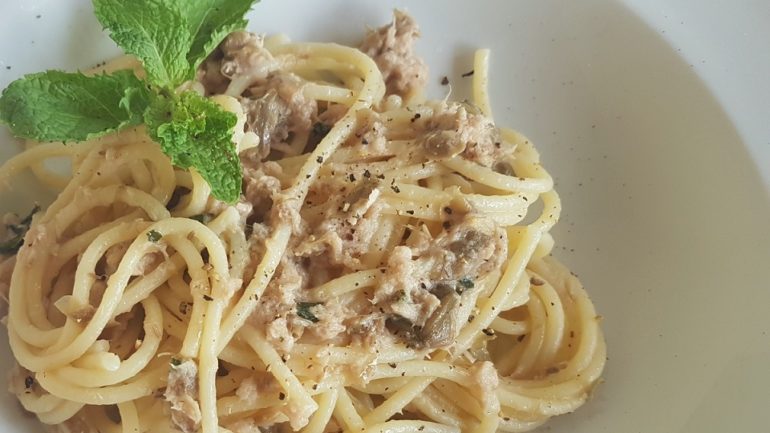
Ingredients:
- 400 g spaghetti
- 240 g tuna canned or in a jar
- 1 lemon
- 1/2 cup capers salted
- 6-8 mint fresh leaves
- salt for pasta water
- black pepper ground, to taste
- 3 tbsp olive oil extra virgin
Method:
- Put the water onto boil for the pasta, add salt once the water starts boiling.
- Rinse the capers under cold running water to remove the salt.
- Then put the capers, the mint and drained tuna into a food processor or blender ( I used a hand held mixer)
- Add the olive oil, the juice from the lemon, plus some grated lemon rind and season with freshly ground pepper.
- Cook the pasta al dente in the boiling salted water according to the instructions on the packet.
- When the pasta is almost cooked remove a cup of the cooking water. Add half of this water to the ingredients for the dressing and pulse a few times until you have a rough sauce. (you don’t want it to be too smooth)
- Once the pasta is done cooking, drain it and return it to the pan with the dressing.
- Add the rest of the saved pasta cooking water and mix everything together until the sauce starts to look creamy.
- Serve immediately with a few whole capers and a bit of mint sprinkled on top. Buon Appetito!
You can use other types of long or short pasta, depending on your preference.
Reference:
https://www.the-pasta-project.com/spaghetti-with-tuna-mint-capers/
https://www.the-pasta-project.com/spaghetti-with-tuna-mint-capers/2/
U
Spaghetti all'ubriaco - Drunken Spaghetti (red wine pasta)
Italian pasta recipe for special occasions like Valentine’s or Christmas, maybe from Tuscany
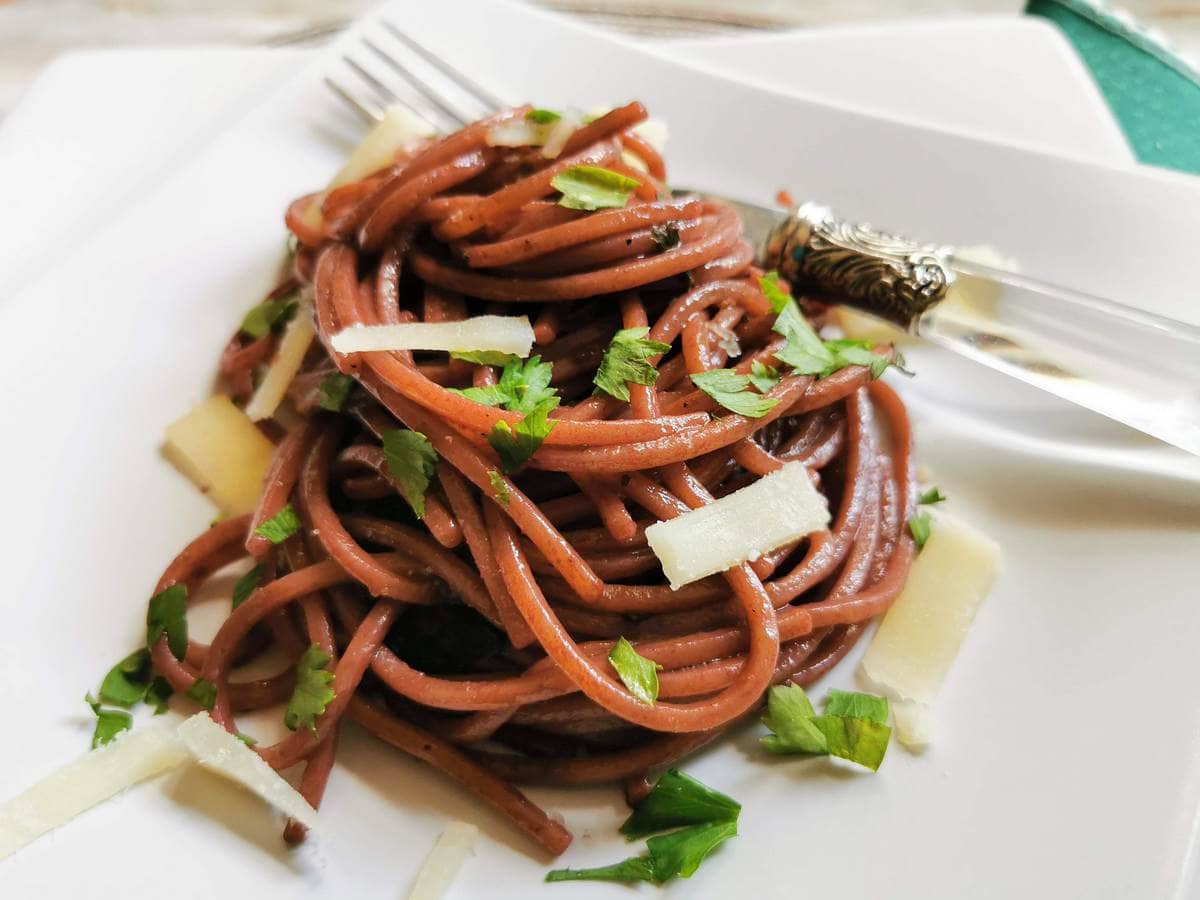
Ingredients:
- 1 bottle medium to full bodied red wine Merlot, Chianti, Valpolicella Ripasso, Sangiovese etc
- 13 oz spaghetti I used spaghetti alla chitarra by Ligouri
- 2 garlic cloves peeled and halved
- 1 handful fresh parsley washed and chopped
- 1 fresh or dried peperoncino (red chili pepper) cut into small pieces
- Pecorino cheese or vegetarian cheese. for grating
- salt for pasta and to taste
- freshly ground black pepper. to taste
- 2-3 tbsp extra virgin olive oil.
Method:
Preparation steps
- Pour the wine minus half a glass (2.5floz) into a saucepan, bring it to a boil and cook for 15-20 minutes. Put a pot of water on to boil for the pasta. Add salt once it starts to boil and bring to a boil again.
- Wash and chop a handful of parsley. Peel and halve 2 garlic cloves and cut the fresh or dried peperoncino into small pieces. Remove the seeds for less heat. Make sure you wash your hands after handling the chili.
- Sauté the garlic, ½ the parsley and the peperoncino in a large deep frying pan or skillet in extra virgin olive oil.
- Cook the spaghetti for just over half the recommended cooking time. Save a little pasta cooking water, Drain the pasta and add it to the skillet.
- Gradually add the wine to the spaghetti one ladle at a time, stirring continuously until the spaghetti is a deep red colour and al dente. If you run out of hot wine before the pasta is cooked, use the saved pasta cooking water. Remove from the heat and mix in the uncooked wine you set aside.
- Serve immediately with more chopped parsley and some grated Pecorino or vegetarian cheese. I used slivers of Pecorino.
Note:
Without cheese, this drunken spaghetti is vegan. I added slivers of pecorino cheese which isn’t vegetarian as it contains animal rennet. So, to make this recipe vegetarian use a vegetarian parmesan or hard cheese.
It’s best to use bronze drawn pasta. This has a rougher surface and is more absorbent than other pasta. It also releases more starch which is exactly what you need when cooking pasta like risotto.
All recipes for drunken spaghetti call for a medium to full bodied red wine. Good wines to use are Merlot, Chianti, Sangiovese or Nero d’Avola. I used Valpolicella Ripasso Superiore.
Reference:
https://www.the-pasta-project.com/drunken-spaghetti-recipe-red-wine-pasta/
V
Tagliolini verde con finferli e speck - Pasta with chanterelle mushrooms and speck
from Trentino-Alto Adige, Northern Italian mountain region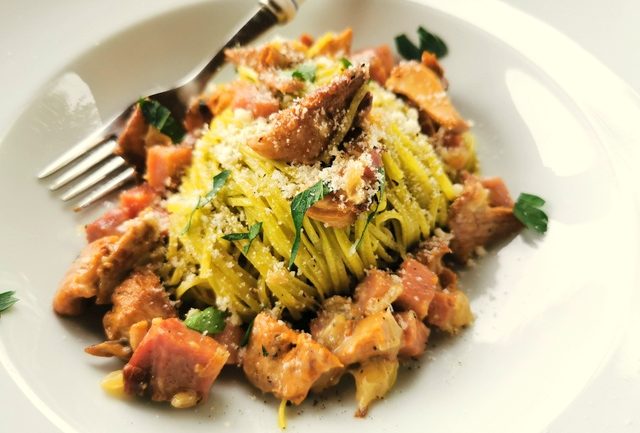
Ingredients:
- 250 g tagliolini pasta (9oz) I used dried spinach taglolini from Pasta Marilungo
- 300 g chanterelle mushrooms (10oz) I used fresh mushrooms, you can also use dried.
- 180 g speck (6-7oz) cubed. You can also use pancetta
- 1 onion peeled and finely chopped
- 1-2 garlic cloves peeled and finely chopped
- 20 g butter (0.70oz)
- 1/2 glass dry white wine
- 200 ml fresh cream (7floz)
- 1-2 tbsp extra virgin olive oil.
- fresh parsley as required (for serving)
- Parmigiano Reggiano or grana grated (for serving)
- salt for pasta and to taste
- ground black pepper to taste
Method;
Preparation
- If using freshly foraged chanterelle mushrooms, they take a little time to clean as it's better to brush any dirt off than wash them. Once they are clean cut into pieces. I prefer to keep the pieces quite large as like all mushrooms they shrink in size when cooked.
- Cut the speck into small cubes. Peel and finely chop the onion and garlic. wash and chop the fresh parsley.
- Put a pan of water on to boil for the pasta. Add salt when it starts to boil. Bring to the boil again.
- Over a medium heat, sautè the onion and garlic in a saucepan with the butter and a little olive oil.
- When the onions are cooked through, add the mushrooms. Let the liquid from the mushrooms evaporate a little bit and then add the white wine and continue to simmer for a couple minutes until the alcohol has evaporated too.
- Add the speck to the mushrooms, mix well and cook everything together for 10 minutes. Stir to keep ingredients from sticking to the pan.
- Stir the cream into the sauce, mix everything well and lower the heat so it just simmers for 5 minutes. Add salt and pepper to taste.
- While waiting for the sauce to cook, cook the pasta al dente according to the instructions on the packet. Tagliolini don't take very long to cook. When the pasta is ready, drain it, but save a cup of the pasta cooking water.
- Add the cooked pasta to the pan with the sauce and mix well. If the sauce is too thick or dry, add some of the water used for cooking the pasta. Mix carefully to coat the pasta with the sauce.
- Serve immediately sprinkled with parsley and grated cheese.
Note:
You can make this pasta with fresh or dried tagliolini or tagliatelle.
If you don’t have speck, use pancetta instead. Obviously the flavour is slightly different, but still delicious.
You can also use other types of fresh mushrooms instead of chanterelles. Or dried instead of fresh mushrooms.
Reference:
https://www.the-pasta-project.com/pasta-with-chanterelle-mushrooms-and-speck/
Spaghetti alle vongole in bianco - Spaghetti with clams (original recipe)
traditional Neapolitan dish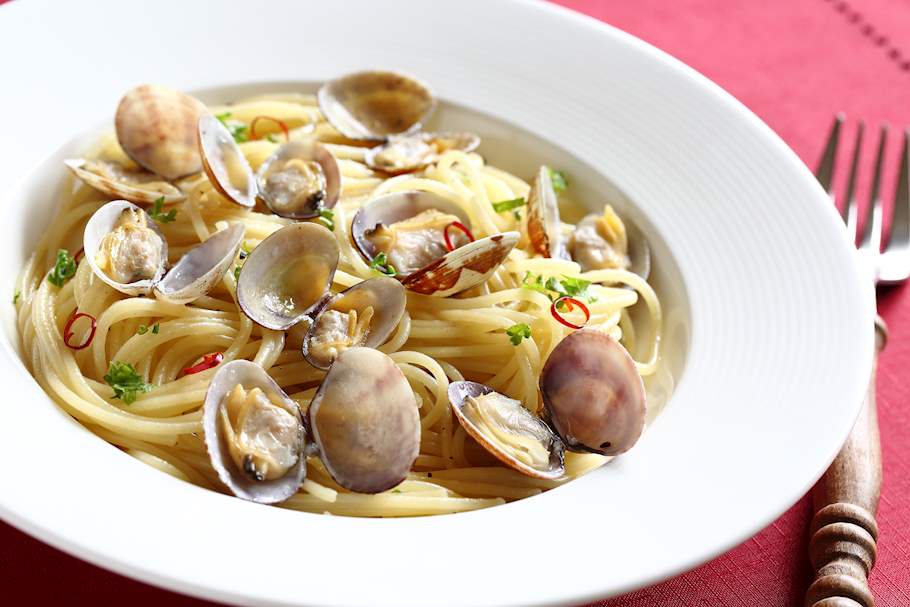
Ingredients:
- 320-400 g linguine (11-14oz) or vermicelli or spaghetti
- 800 g fresh clams (1.8lbs) about 200g/7oz per person
- 3-5 garlic cloves peeled and finely chopped
- 1 peperoncino (red chili pepper) or dried flakes amount depends on your preference
- 4-5 tbsp extra virgin olive oil
- 1-2 handfuls fresh parsley finely chopped
- salt to taste (we don’t add it to the pasta cooking water)
- 1/2 glass dry white wine
- Chop the peeled garlic and parsley finely. If using a whole fresh or dried red chili chop finely too. Remove the seeds to make it milder. Be careful not to touch your eyes or mouth after doing this and wash your hands well before continuing to cook.
- Wash the clams in cold water and remove any with broken shells. Some kinds of clams need a lot of rinsing if they have sand in them. But you can also filter the liquid after you have precooked them, so don’t worry so much about the sand.
- Put a pot of water on to boil for the pasta. When it starts to boil add the pasta. You probably don’t need salt as the clams will already be a little salty.
- While the water is boiling for the pasta, put the clams in a deep frying pan and cook covered over a medium to high heat until they have opened. (about 5 minutes)
- Allow the clams to cool a little and then remove the meat from most of the clam shells keeping some intact. Discard the empty shells and, if necessary, filter the liquid that the clams have produced. Don’t discard it.
- Cook the pasta al dente according to the instructions on the packet.
- Heat half the olive oil in a frying pan or skillet. Add the garlic and peperoncino. Cook until the garlic starts to soften. Add the clams (with shells and without) with their liquid to the pan and cook for a few minutes. Then, add the white wine and cook further until the alcohol evaporates. Finally, add the parsley and the rest of the olive oil. Continue cooking for another 3-5 minutes and then turn off the heat.
- When the pasta is cooked, drain it and add to the pan with the cooked clams. Mix everything together well and serve immediately with another sprinkling of chopped parsley, if required.
Note:
Pasta
Although spaghetti is the pasta of choice, vermicelli, linguine, and even spaghettini pasta can be used instead. No matter which pasta you choose, it must be cooked al dente if the dish is to be a success.
Clams
The original spaghetti alle vongole is prepared with either carpet-shell clams or bean clams, but you can use littlenecks, Manila clams, and cockles instead.
In any case, it’s important that you purge them of any sand by placing them in cold and generously salted water for a couple of hours. Change the water every 30 minutes until there is no grit or sand at the bottom of the bowl. As the last step, wash them under running water, rubbing them with salt to clean the outsides of the shells.
There are two methods of preparation:
You can steam the clams until they all open, then add the spaghetti,
or do it in two stages, meaning that as each clam opens, you remove it from the pan so that the meat doesn’t overcook, then return them to the pan once you add the spaghetti. The meat can be left inside of the clam, or plucked out, so the dish is easier to eat.
Reference:
https://www.the-pasta-project.com/linguine-pasta-alle-vongole-linguine-with-clams/
Spaghetti alle vongole in rosso -Spaghetti with clams and tomato
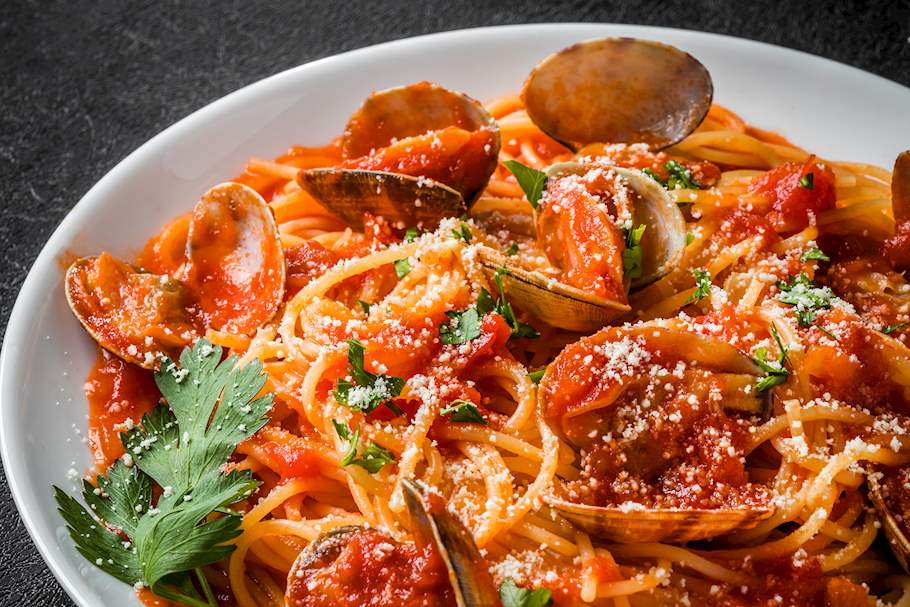
Ingredients:
- 200 gr spaghetti
- 700 gr clams
- 1 garlic clove
- 50 ml tomato sauce
- basil or parsley
- pepper, to taste
- olive oil
- Clean the clams, wash them under water, then place them in a large pan and cover with a lid. Cook over medium heat until they open.
- Once all have opened, turn the heat off and remove the meat from the shell. Filter the clam stock.
- Next, sauté the garlic in olive oil, then add the tomato sauce, and filtered clam stock. Cook for a few minutes over low heat, then add the clam meat and remove from the heat.
- Cook the spaghetti in salted water, then 2 minutes near the end of cooking transfer them into the pan with clam meat and stir. Add a little olive oil and pasta water and stir once again.
- Add basil or chopped parsley. Plate the pasta, sprinkle with pepper, and serve immediately.
Although you can use either tomato sauce or crushed tomatoes, purists claim only bianco version is the original one and that using tomatoes changes the dish completely as they overpower the clams with its sweet and sour flavor.
Reference:
https://www.tasteatlas.com/spaghetti-alle-vongole/recipe/spaghetti-alle-vongole-in-rosso-i
X
Y
Z
Linguine allo zafferano con gamberi - Creamy Italian Prawn Saffron Linguine

Ingredients:
- 400 g linguine (14oz) I used linguine from De Cecco
- 1 kg Fresh unpeeled prawns (about 2 lbs) or defrosted frozen unpeeled prawns
- 2-3 spring onions or shallots
- 1/2 tsp saffron threads or powder
- 1 tsp pink peppercorns
- 30 g butter (1oz)
- 1 handful fresh parsley chopped
- 200 ml heavy cream (6-7floz)
- 1 glass water
- salt for pasta and to taste
Preparation
- Put the saffron threads into a glass with a couple of tablespoons of warm water. Leave to infuse and melt. Peel and slice the onions. Wash and chop the parsley.
- Remove the heads and tails from most of the prawns ( you can leave one per person intact for appearance), peel the prawns keeping just the meat. Remove the black vein along the back of the peeled prawns.
- Put the heads and shells in a saucepan with a glass of water and a teaspoon of salt, bring to a boil and leave to simmer for a quarter of an hour. Remove the heads and shells, strain the broth into a bowl and add the soaking saffron to it.
- Put a pot of water on to boil for the pasta. Add salt once it starts to boil and bring to the boil again.
- Fry the onions in a frying pan or skillet over a low heat with the butter and some pink pepper corns. Once the onions start to soften add the saffron broth. Let it boil over a high heat for a couple of minutes, then turn the heat down and add the whole prawns first and cook for a couple of minutes on both sides. Then add the peeled prawns and continue cooking for another 5 minutes.
- Before adding the cream to the sauce remove the whole unpeeled prawns but keep them warm. Add the heavy cream and mix it into the sauce. Add salt to taste.
- Cook the linguine al dente according to the instructions on the packet. When the pasta is cooked, save a little of the cooking water and drain. Add the pasta to the sauce. Mix everything together well . If it seems dry add a little pasta cooking water. Remove from the heat and serve immediately sprinkled with chopped parsley and with one whole prawn on each plate .
Note:
For this recipe you could also use linguine, spaghetti or tagliatelle.
Reference:
https://www.the-pasta-project.com/italian-prawn-saffron-linguine-recipe/
Fettuccine allo zafferano e zucchine - Fettuccini pasta with saffron and zucchini
from Abruzzo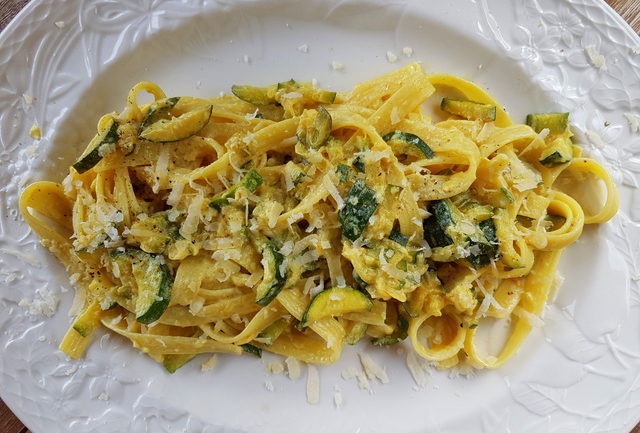
Ingredients:
- 400 g fettucine rigate (14oz) or other pasta of your choice
- 3-4 zucchini long and thin
- 1 spring or white onion
- 50 ml vegetable or chicken stock (1.5-2 floz)
- 1-2 tbsp extra virgin olive oil
- 50 g grated parmesan (2oz)
- 100 ml cooking cream (3.5 fl oz)
- 1/2 tsp saffron threads or 1 sachet of saffron
- salt for pasta and to taste
- ground black pepper to taste
Method:
- 2 hours before cooking, steep the saffron threads (if you are using threads) in 2 -3 tablespoons of hot water.
- Wash the zucchini, discard the ends and slice them to a thickness of about 4 millimeters and then cut these zucchini slices into juliennes
- Peel and chop the onion very finely.
- Put a pan of water onto boil for the pasta. Add salt once it starts to boil.
- Heat the oil in a frying pan. Add the onion and cook until it starts to soften. Then add the zucchini and cook for another couple of minutes.
- Add half the broth and continue cooking for a couple of minutes.
- Add a pinch of salt, small ground pepper and cook for 2-3 minutes on a higher flame, stirring often.
- Stir the saffron into the remaining broth, then add it to the zucchini. Stir and cook for a further 2-3 minutes.
- Pour in the cooking cream, mix and continue cooking for 5 minutes on medium heat, covered until the zucchini are cooked al dente. Add some grated parmesan. Mix well and turn off the heat until pasta is cooked,
- Cook the pasta al dente in the boiling salted water according to the instructions on the packet.
- Save some of the pasta cooking water and drain the pasta.
- Reheat the sauce, if necessary.
- Add the pasta to the sauce, mix everything together well and cook for a couple of minutes on a low heat. You can add some of the pasta cooking water if you think the sauce is too dry.
- Serve immediately with a sprinkling of grated parmesan and more ground pepper to taste.
Note:
This recipe can be made with all kinds of pasta, either fresh or dried, smooth or ridged.
Reference:
https://www.the-pasta-project.com/pasta-with-saffron-and-zucchini/2/
https://www.the-pasta-project.com/pasta-with-saffron-and-zucchini/
